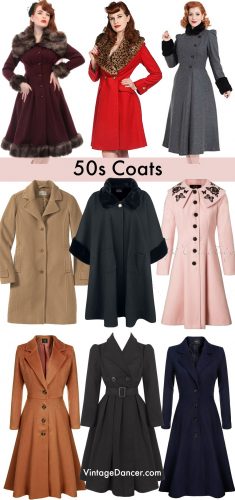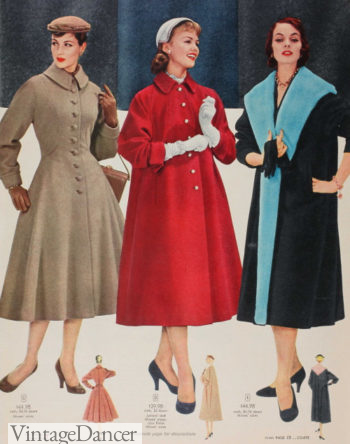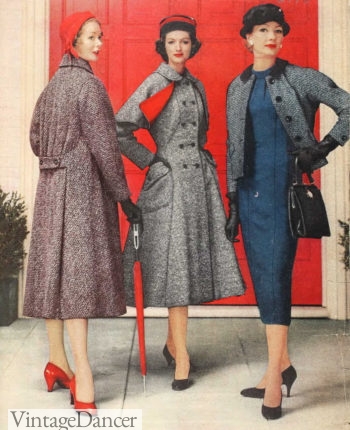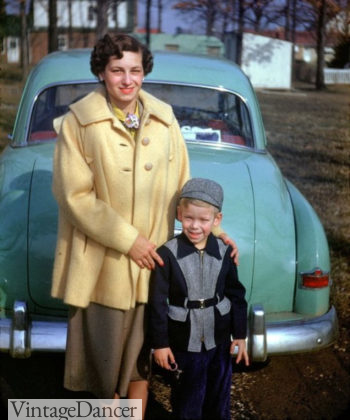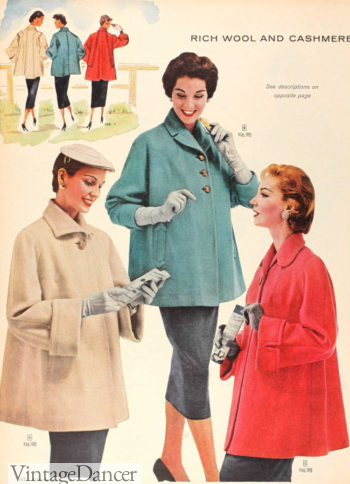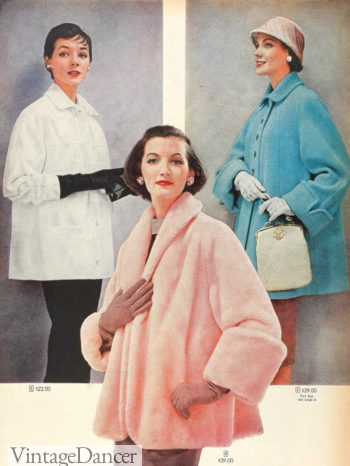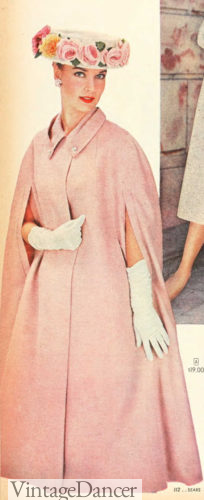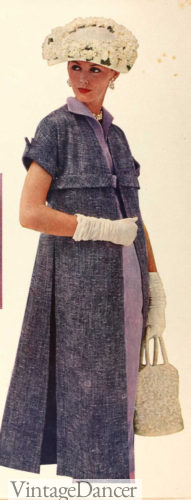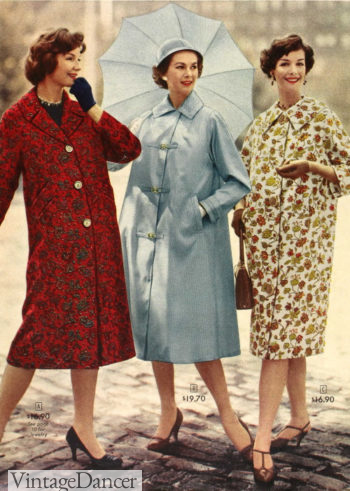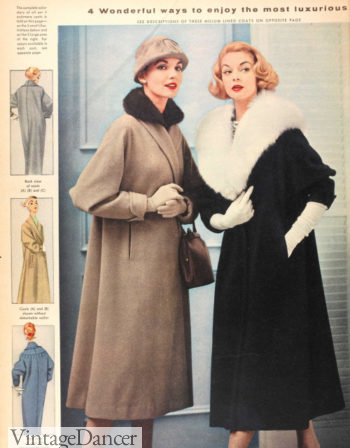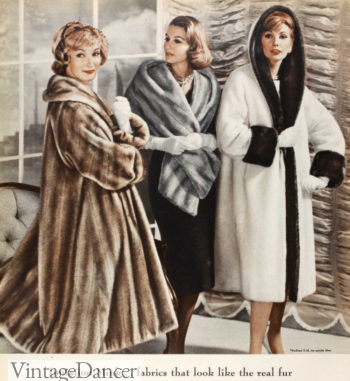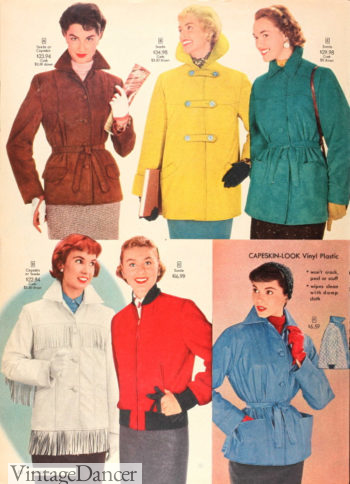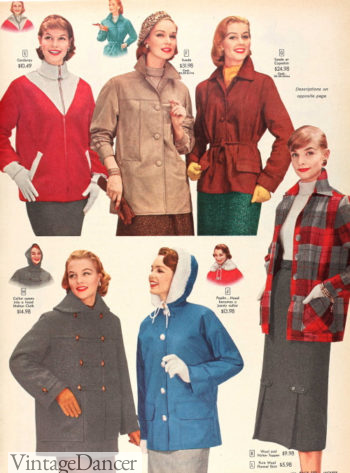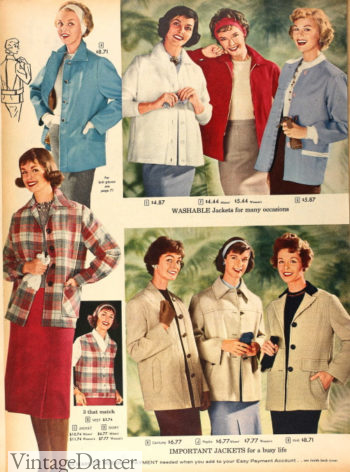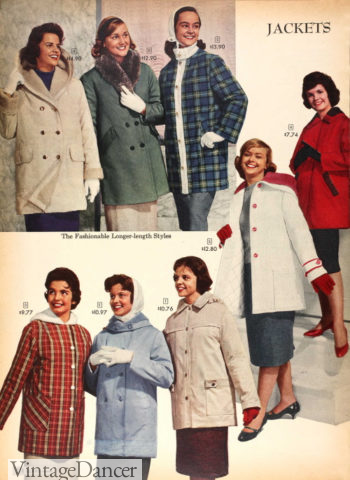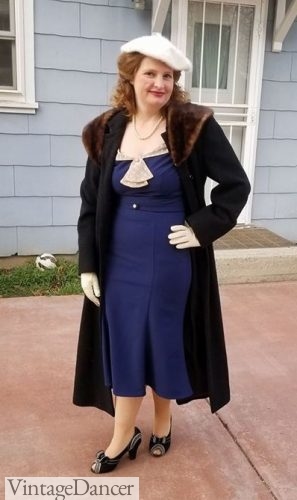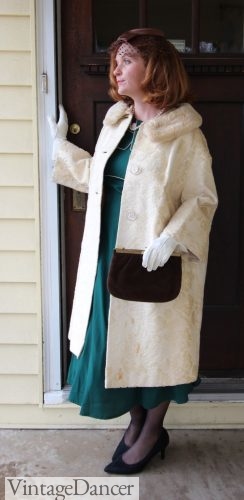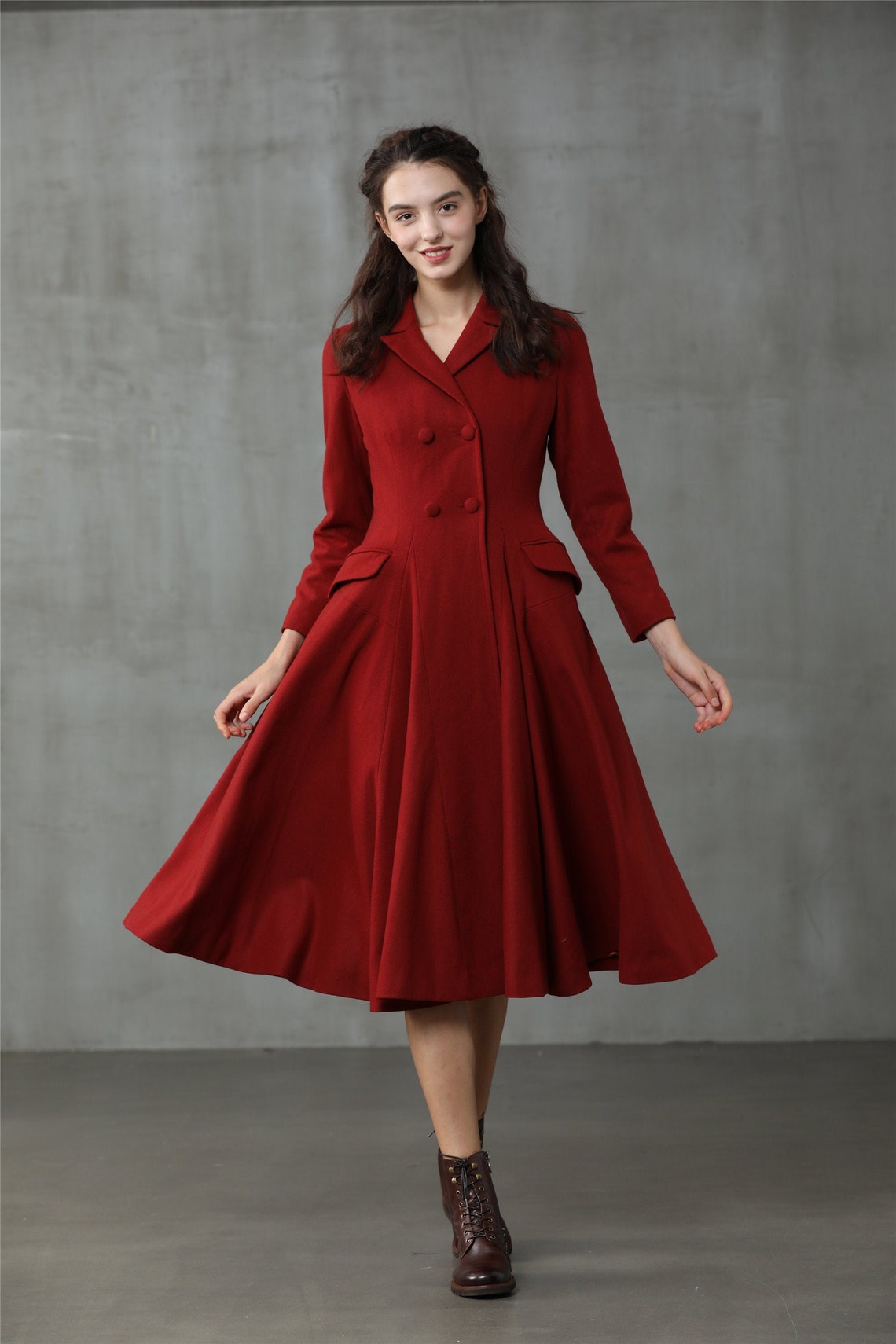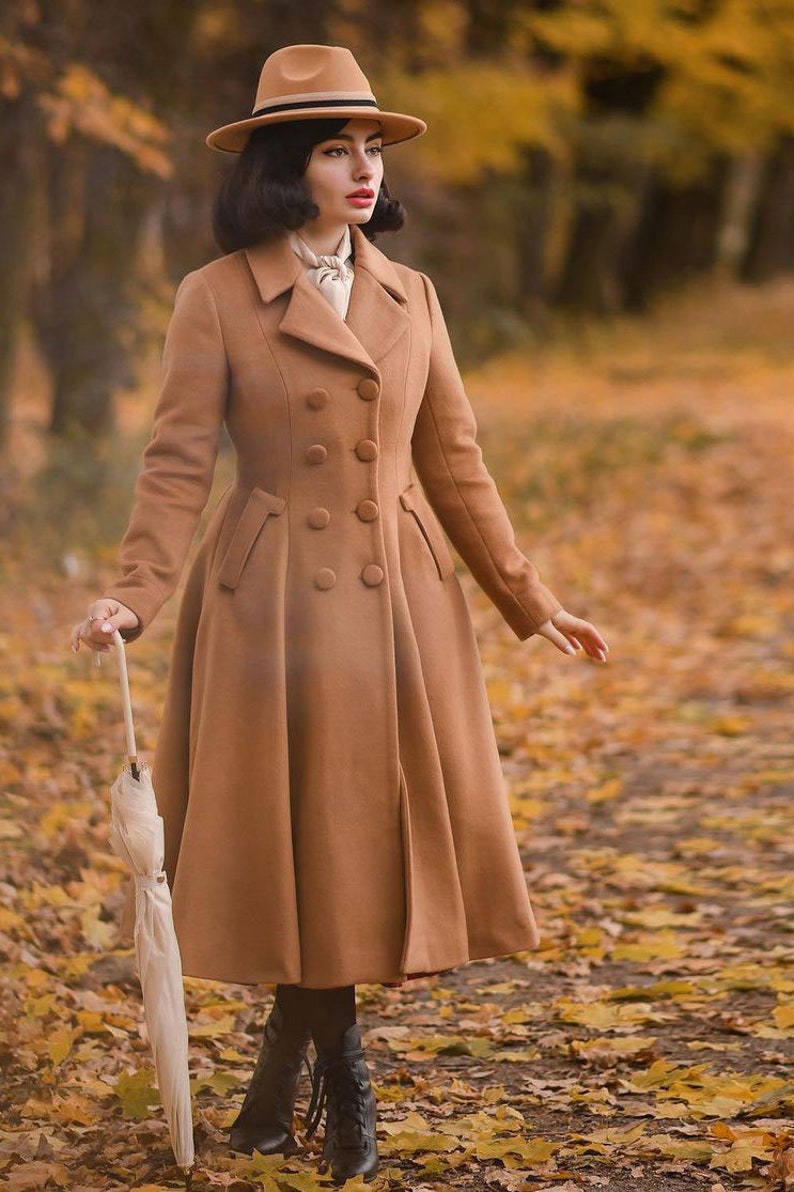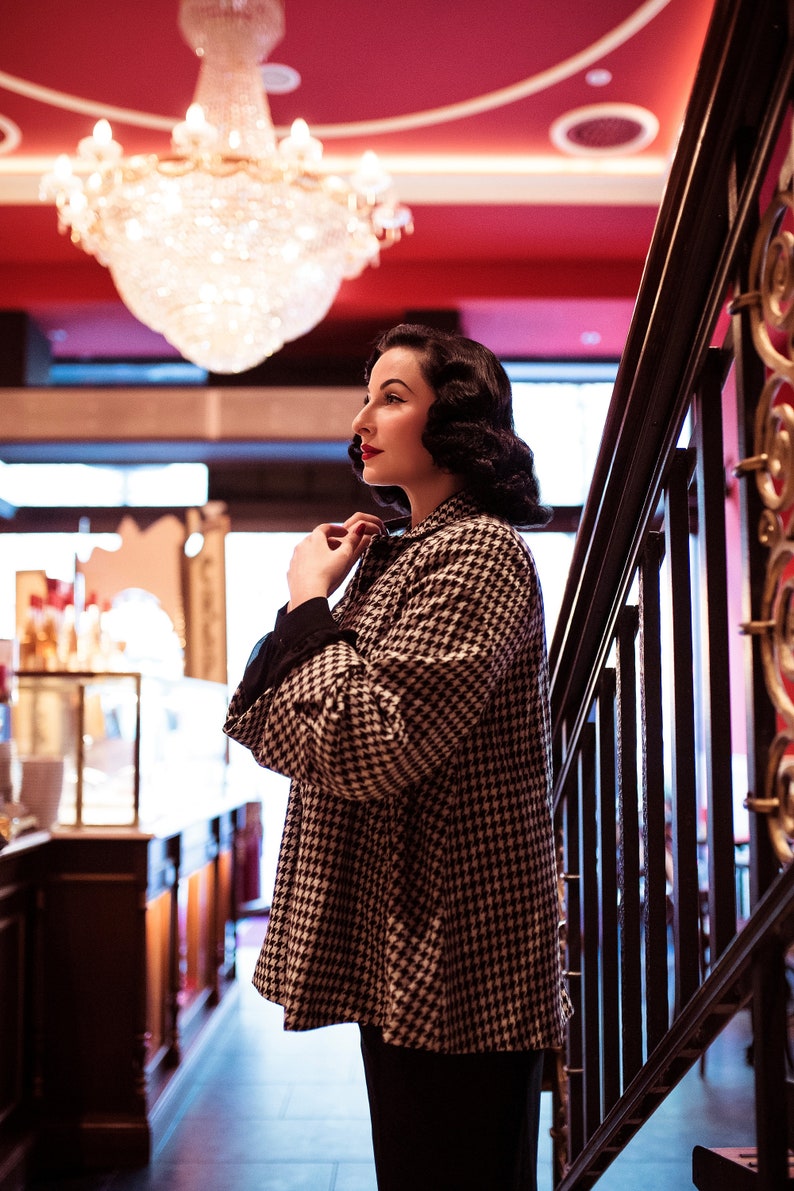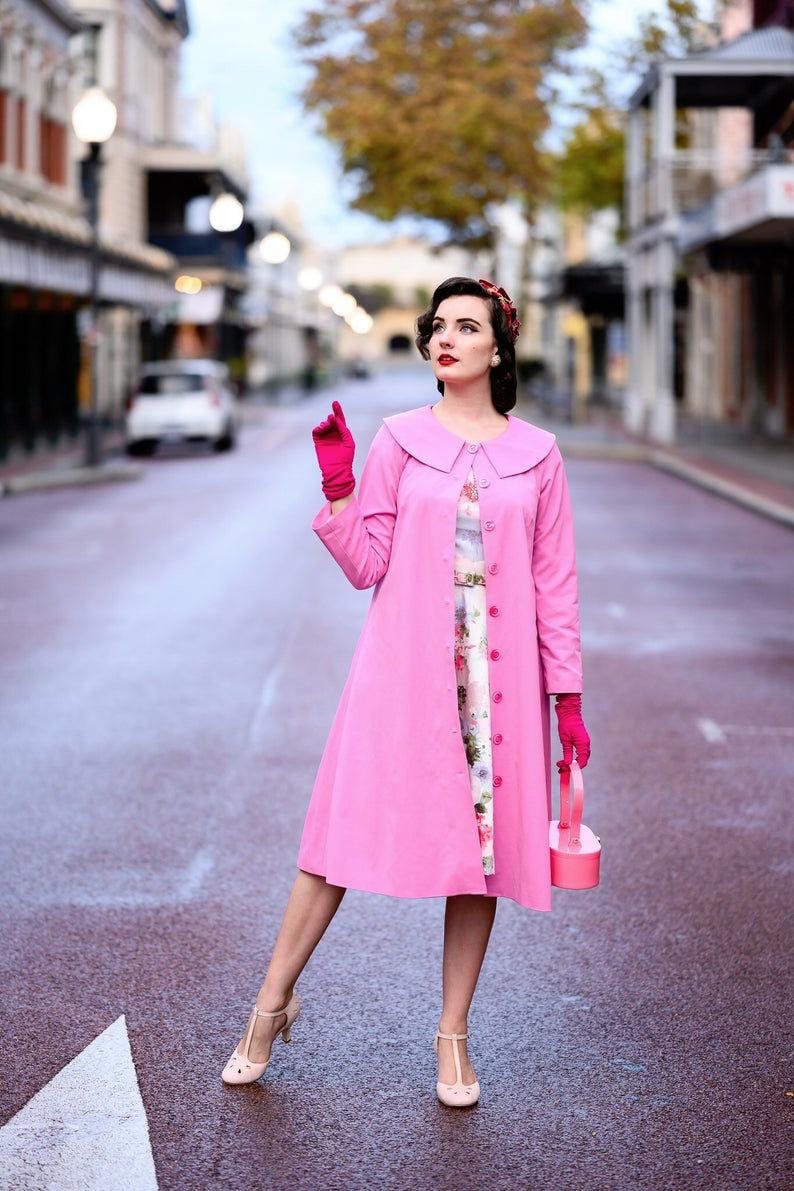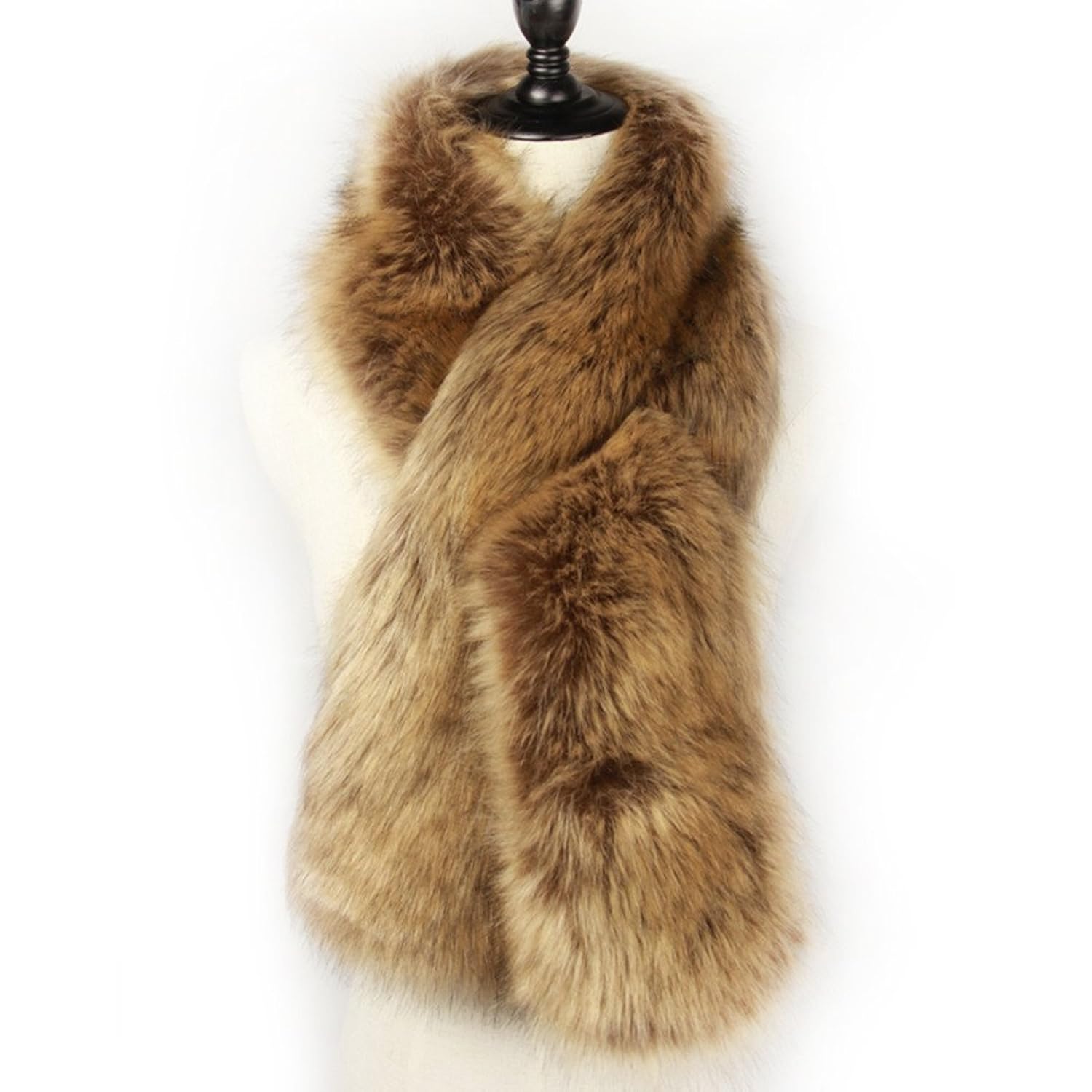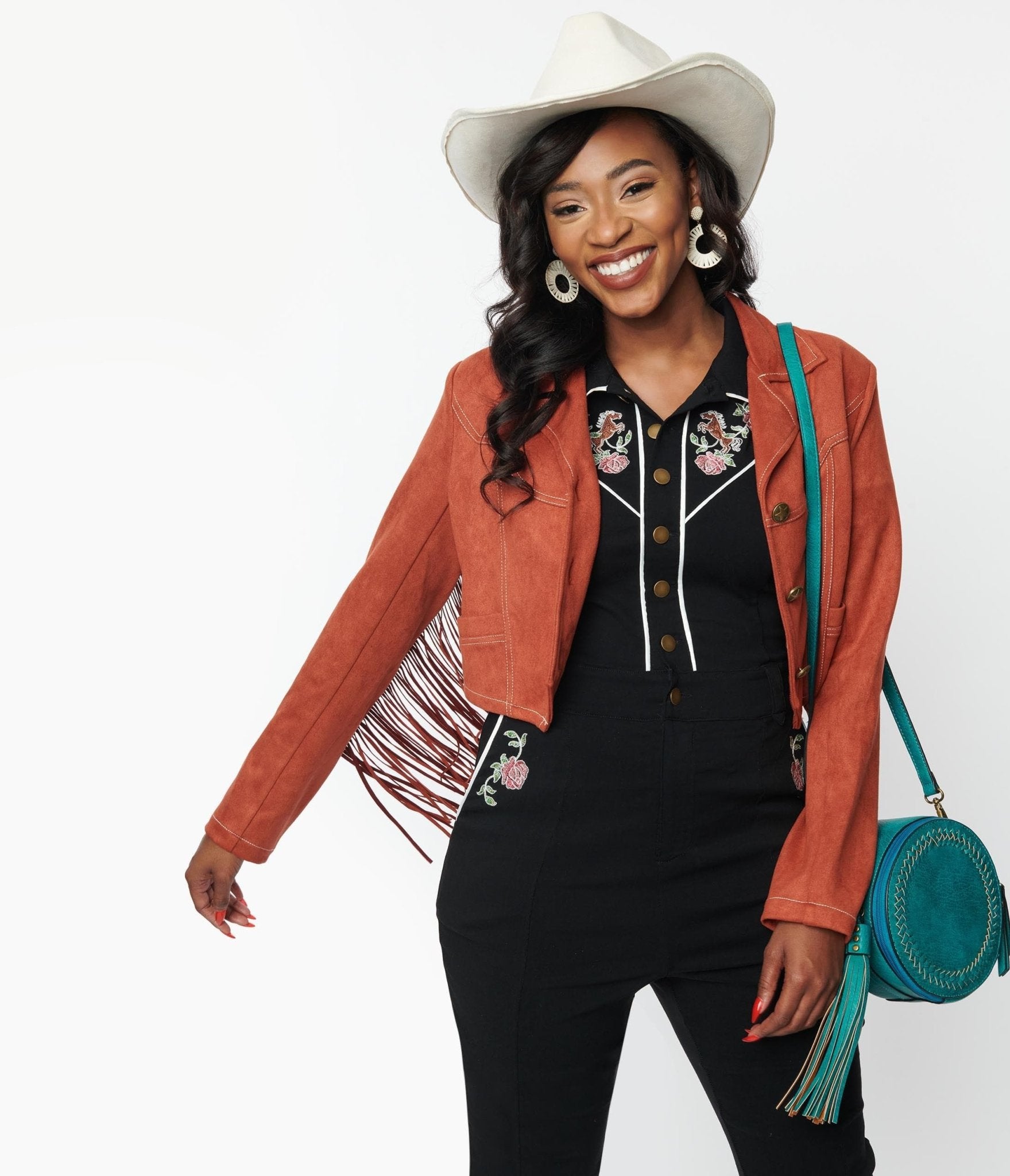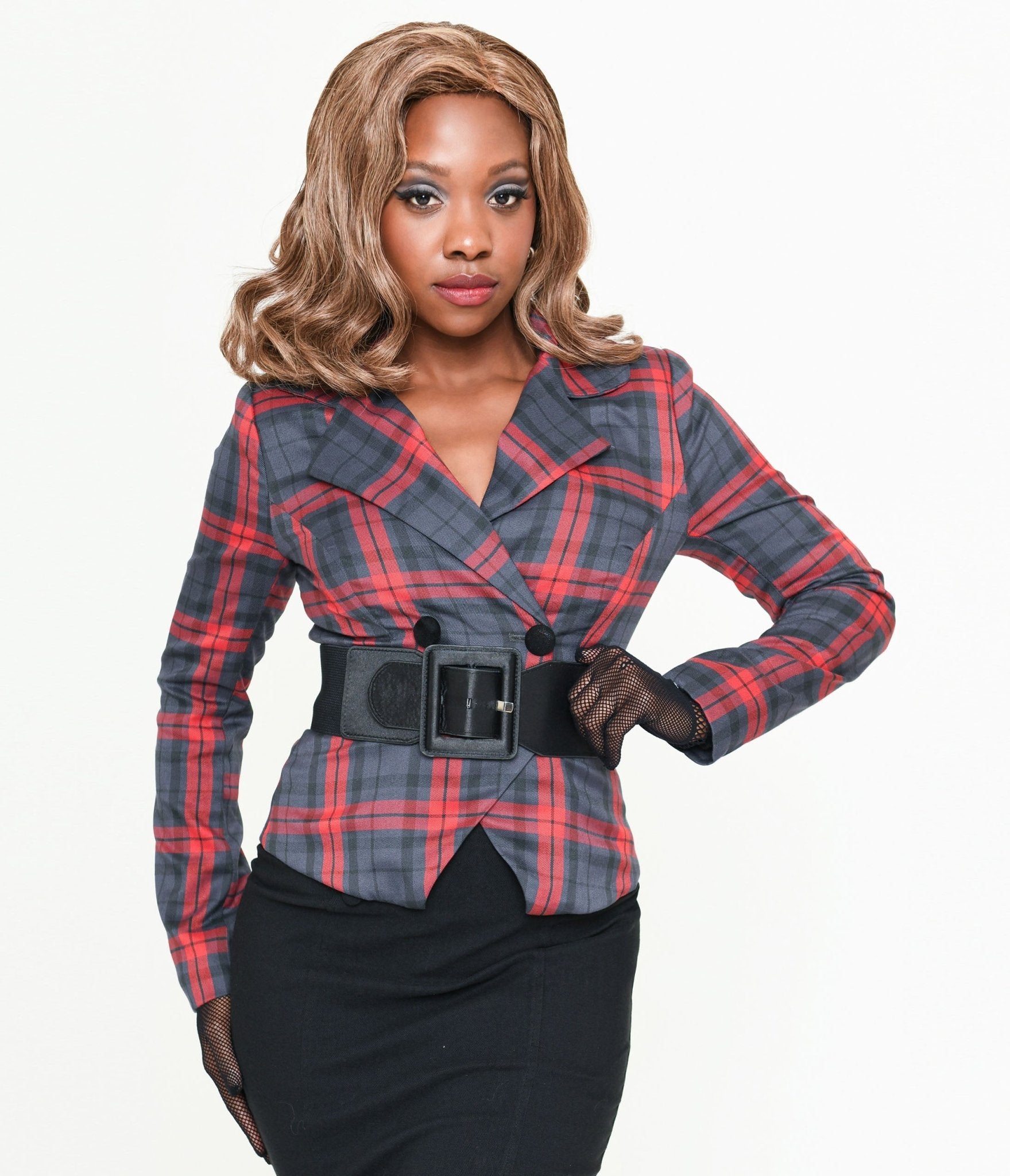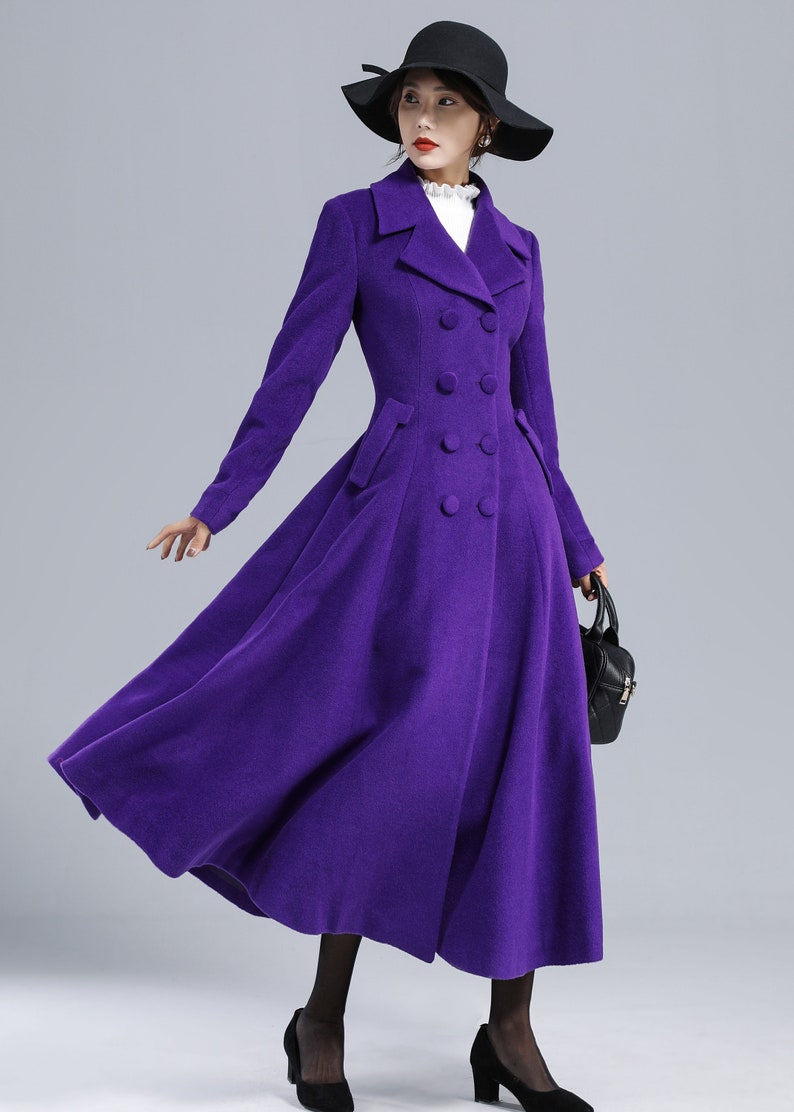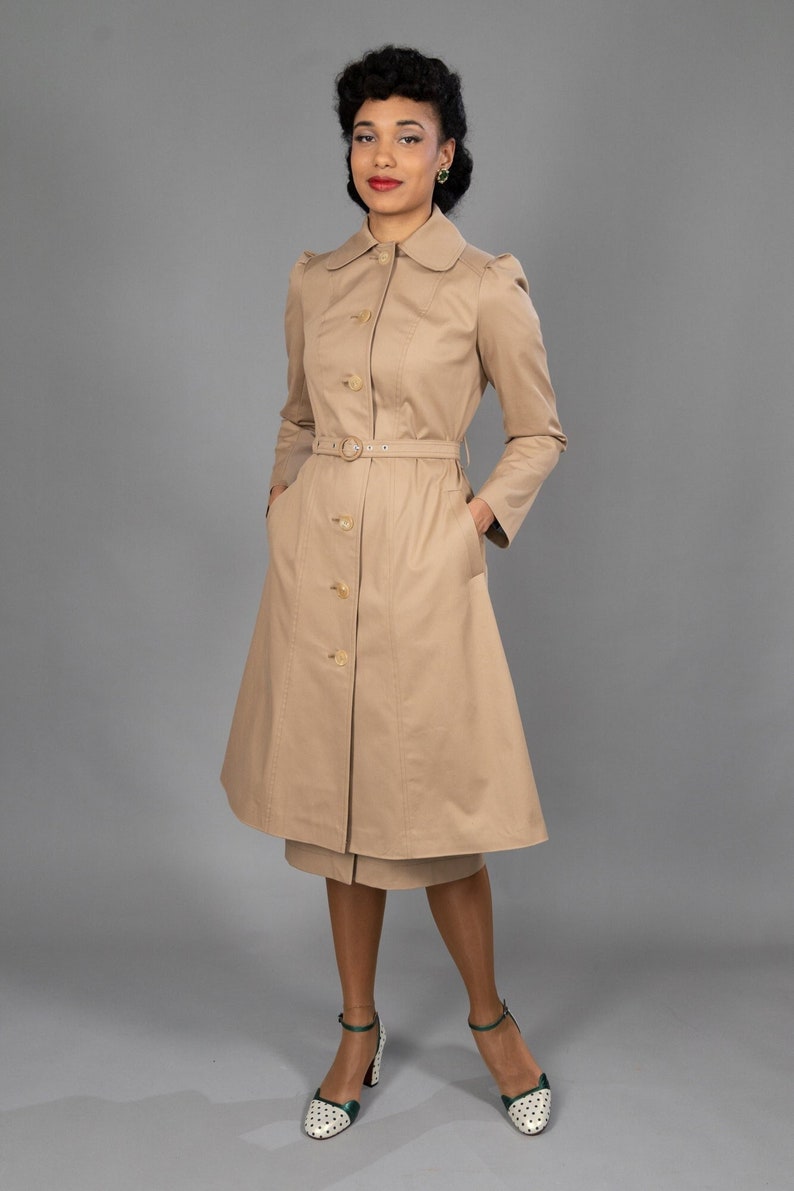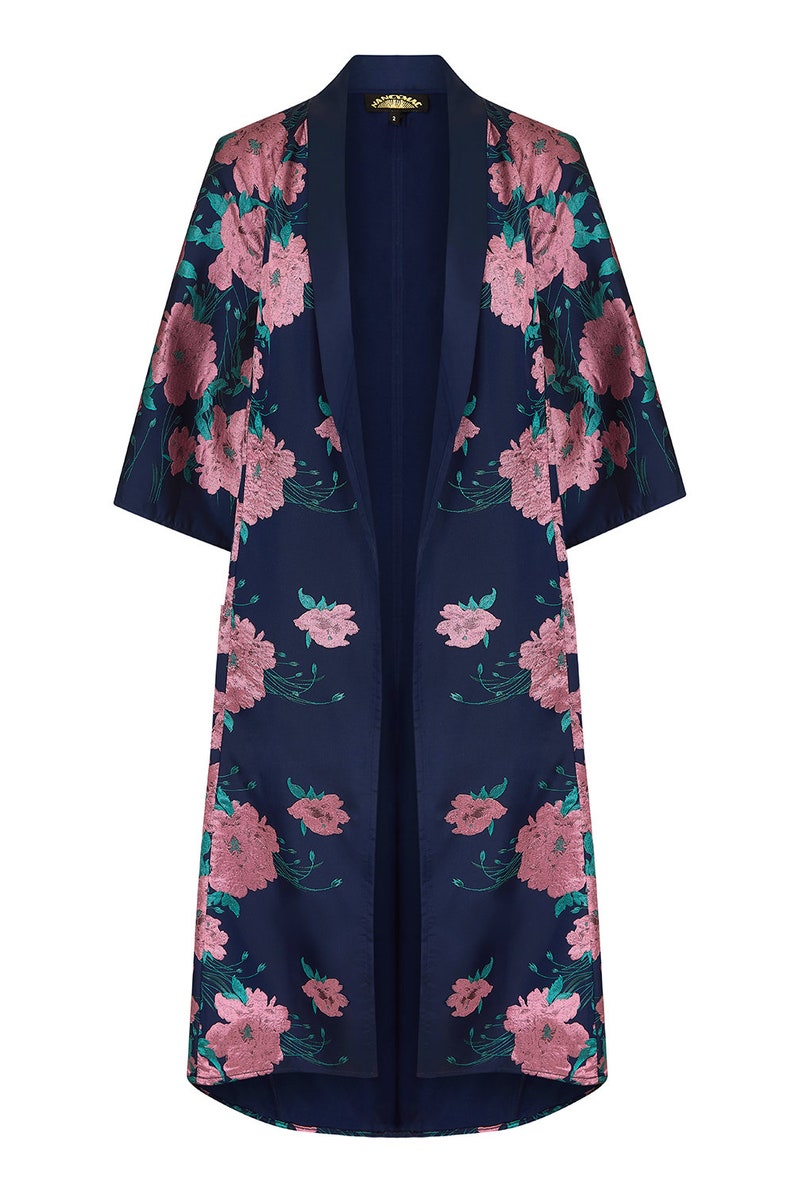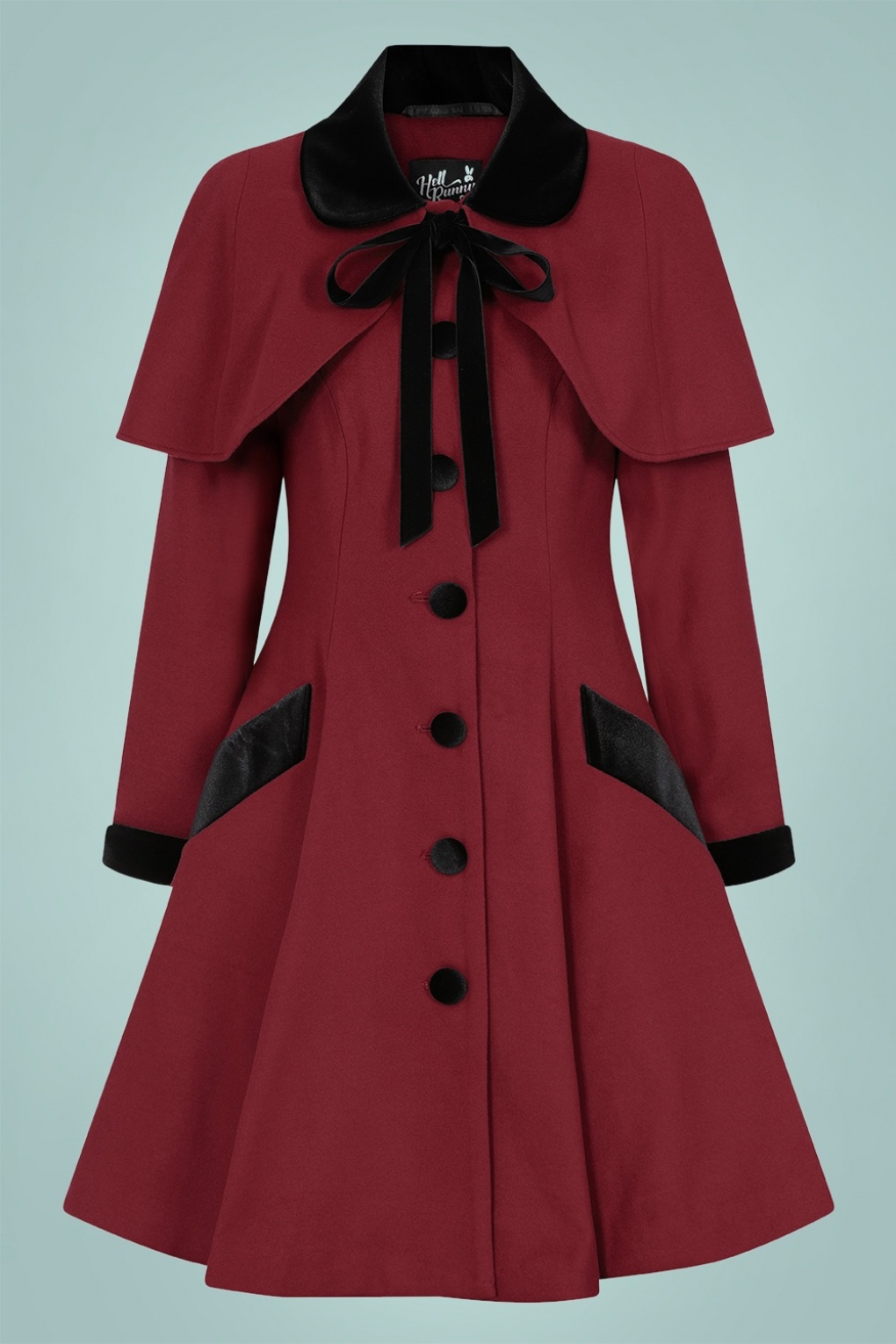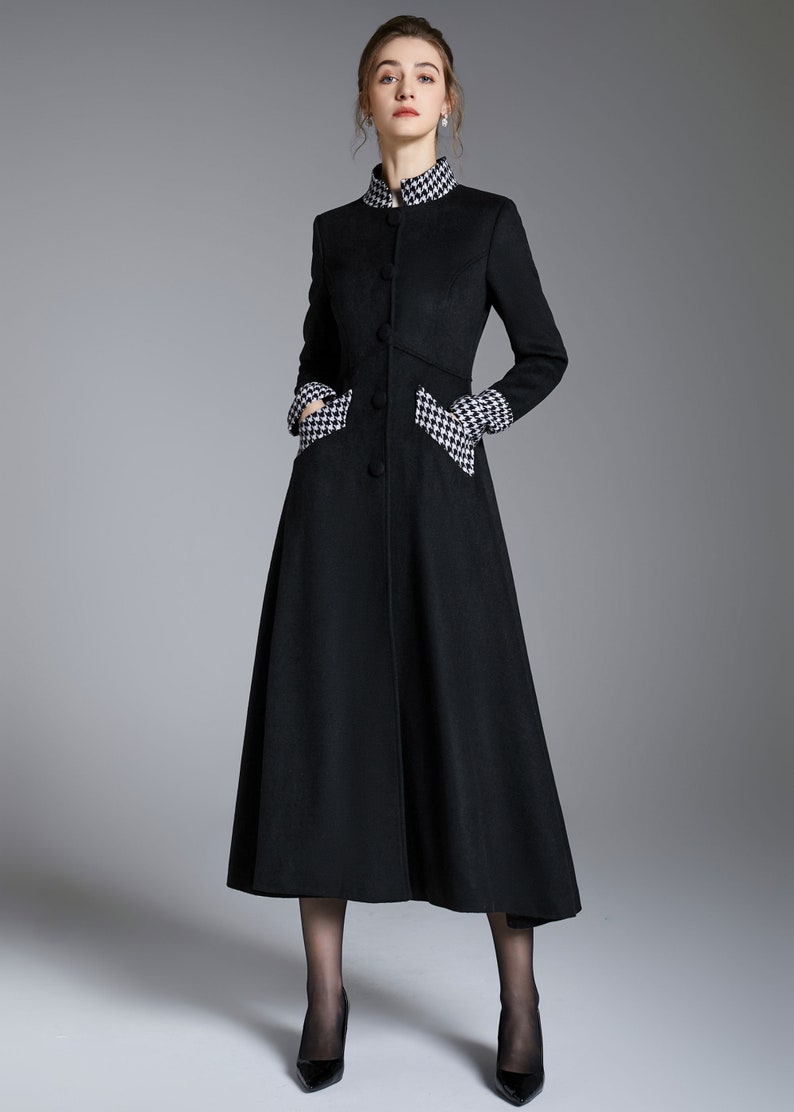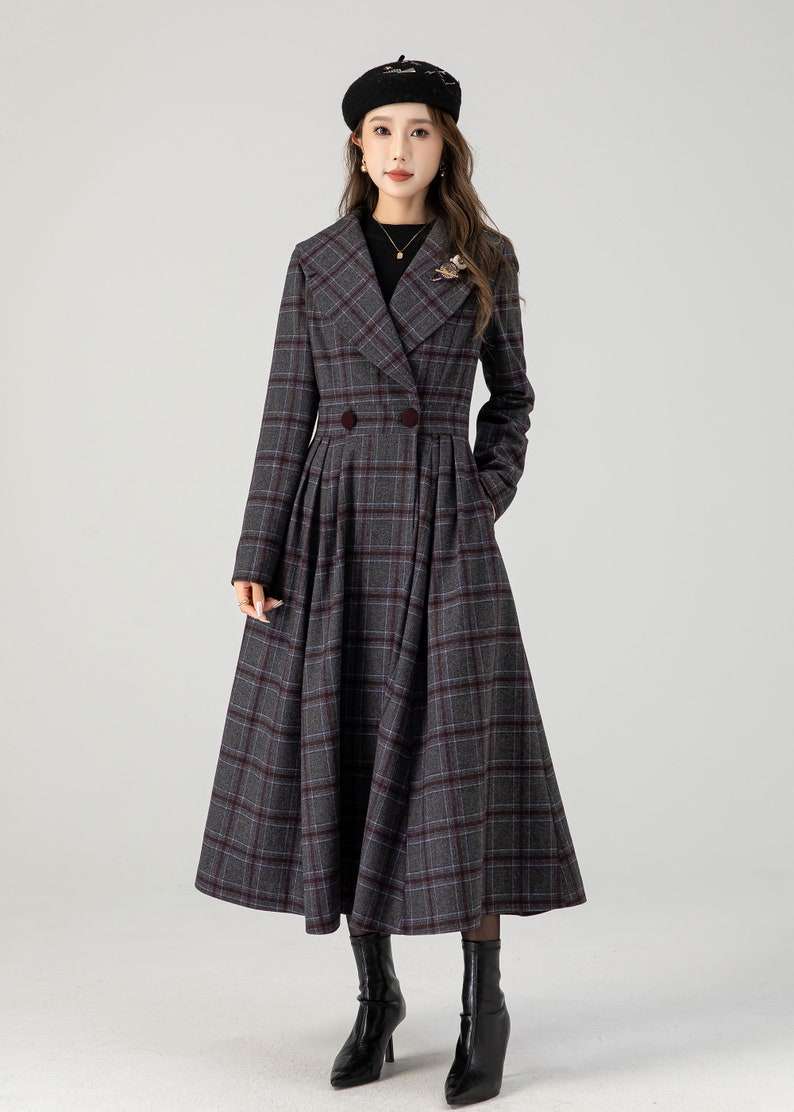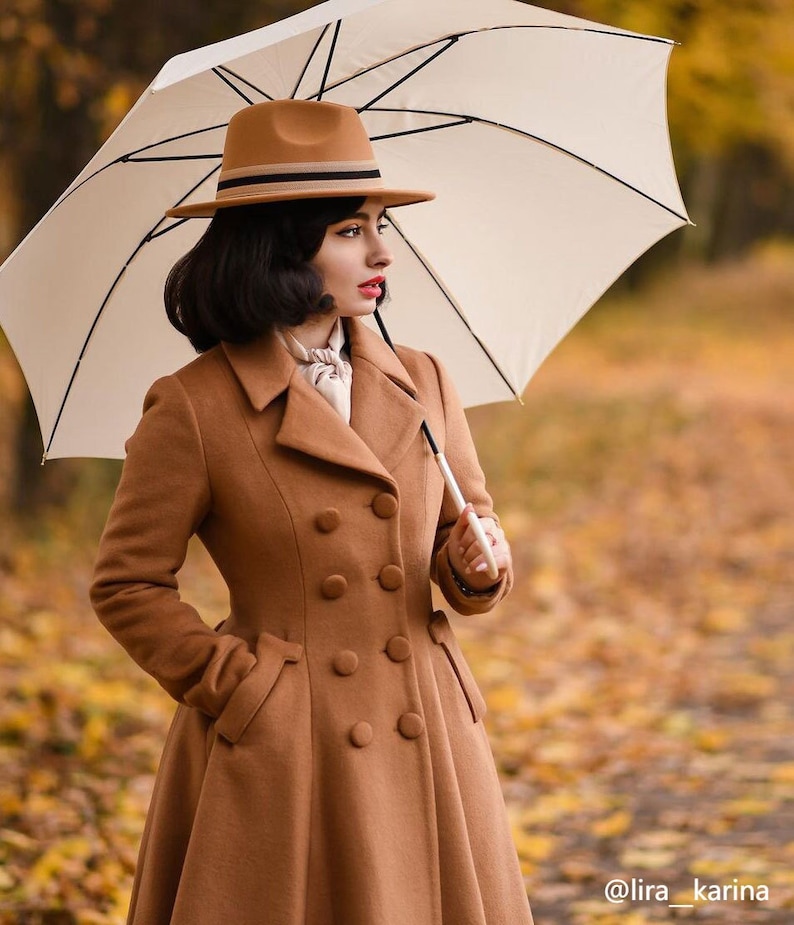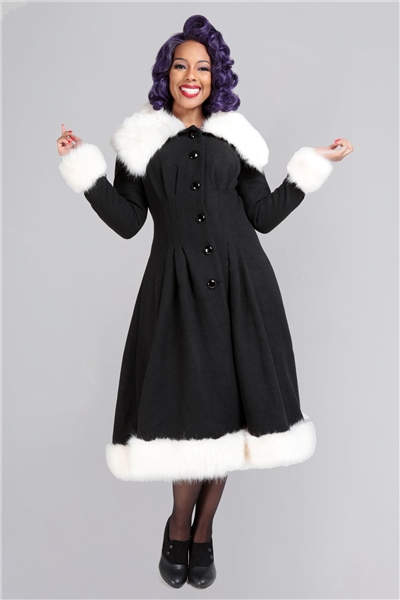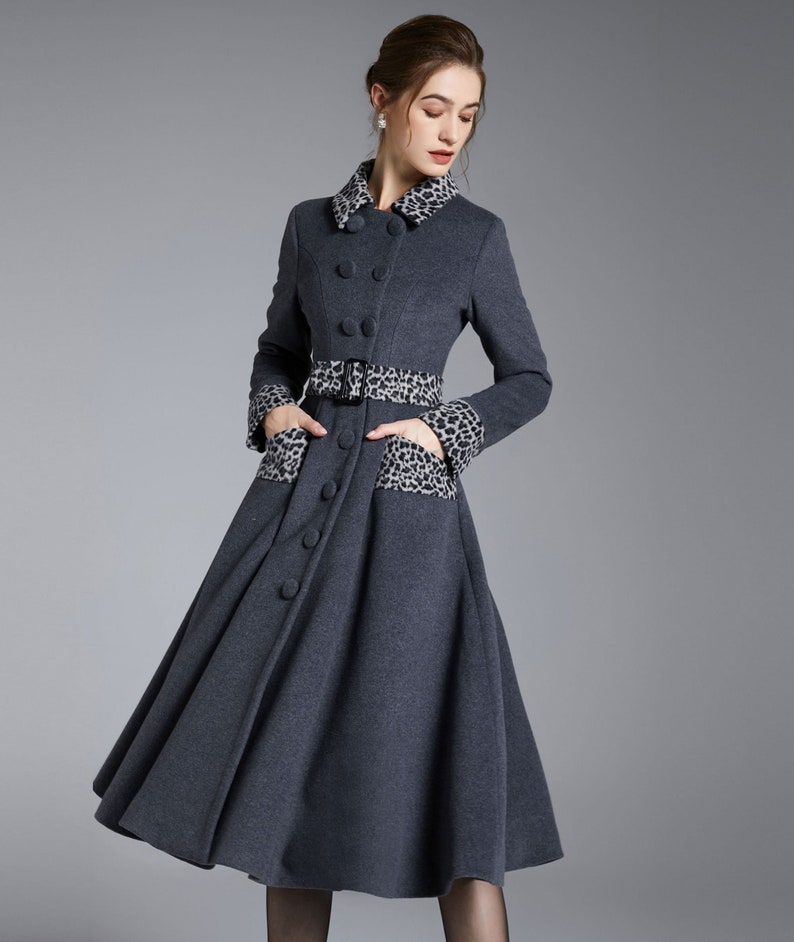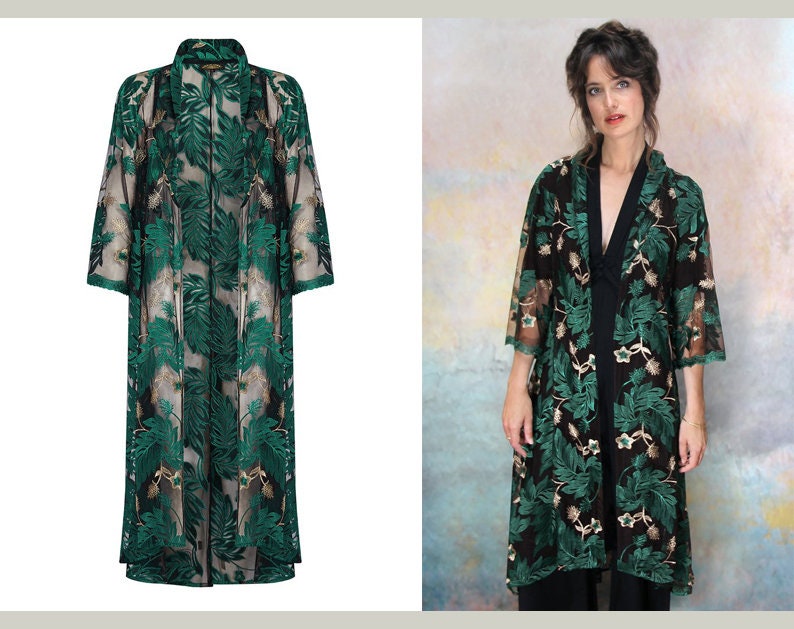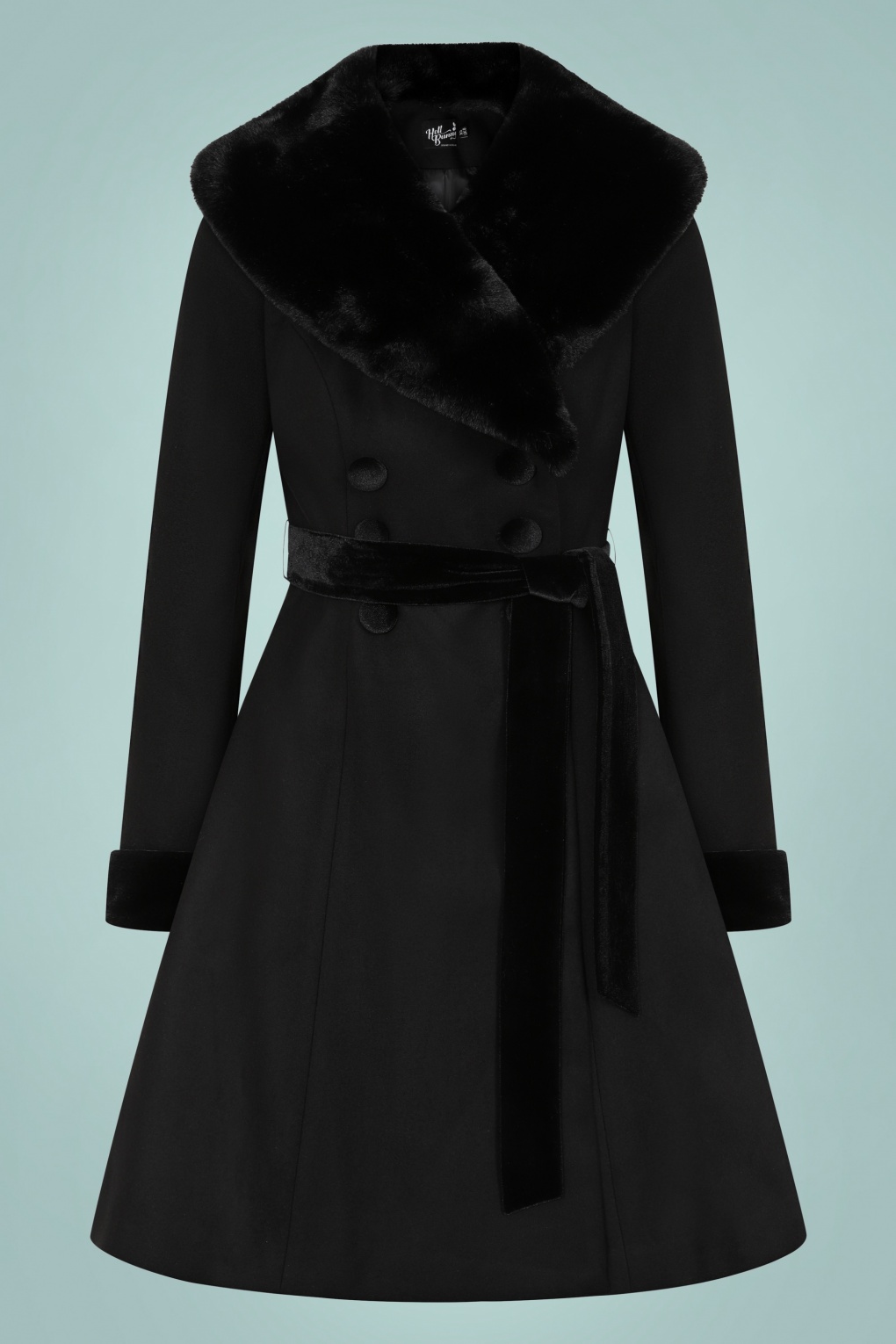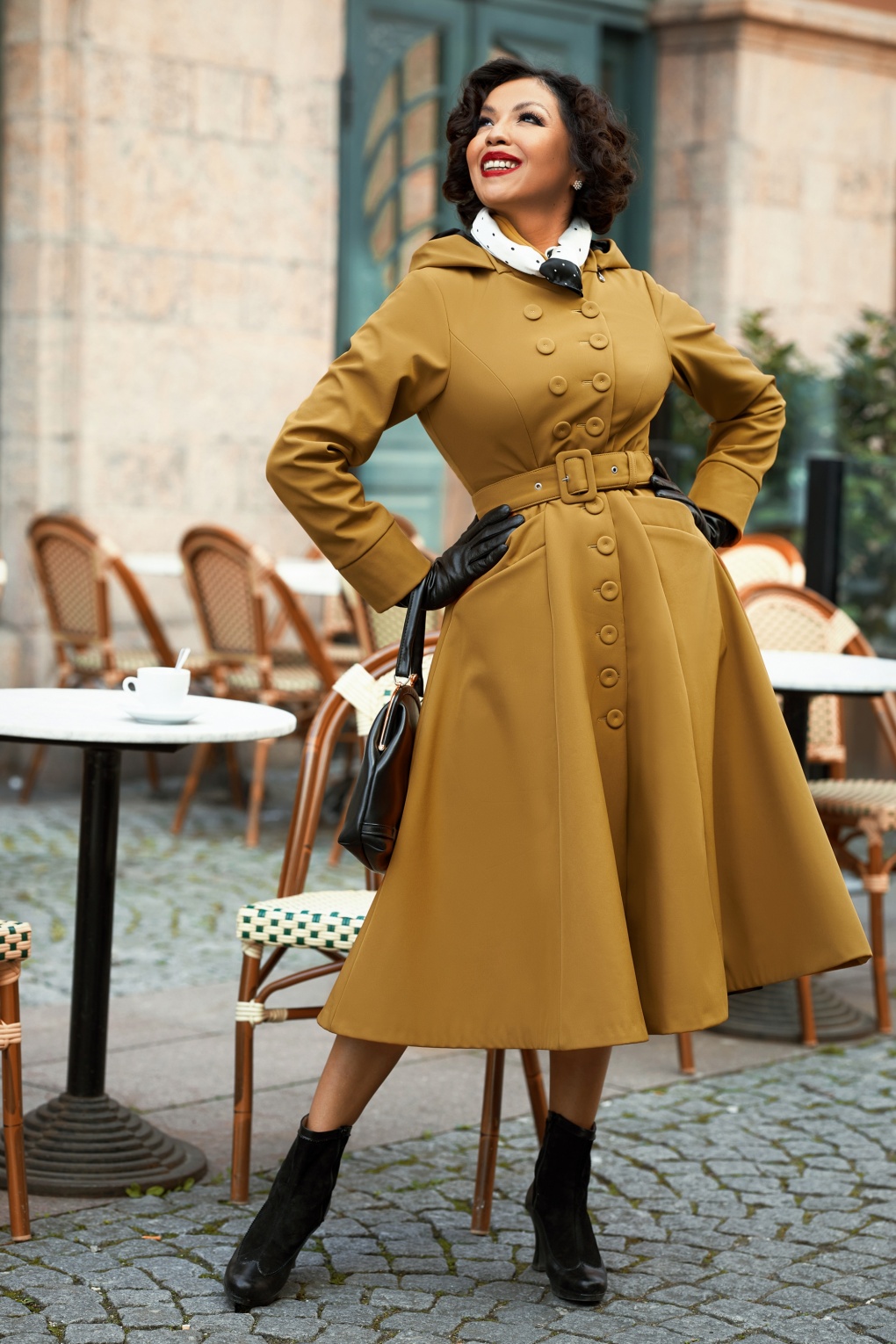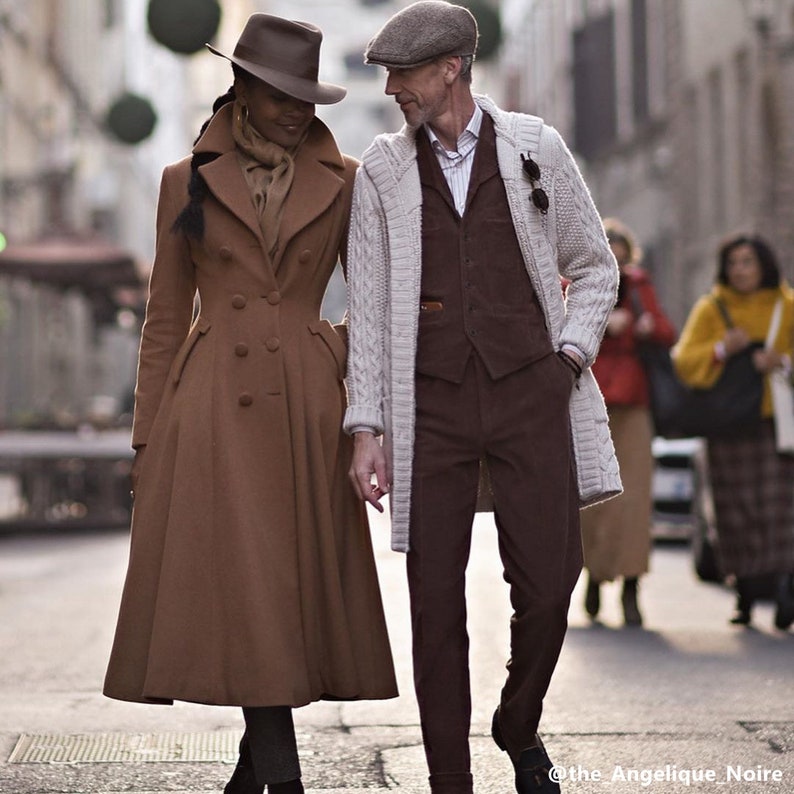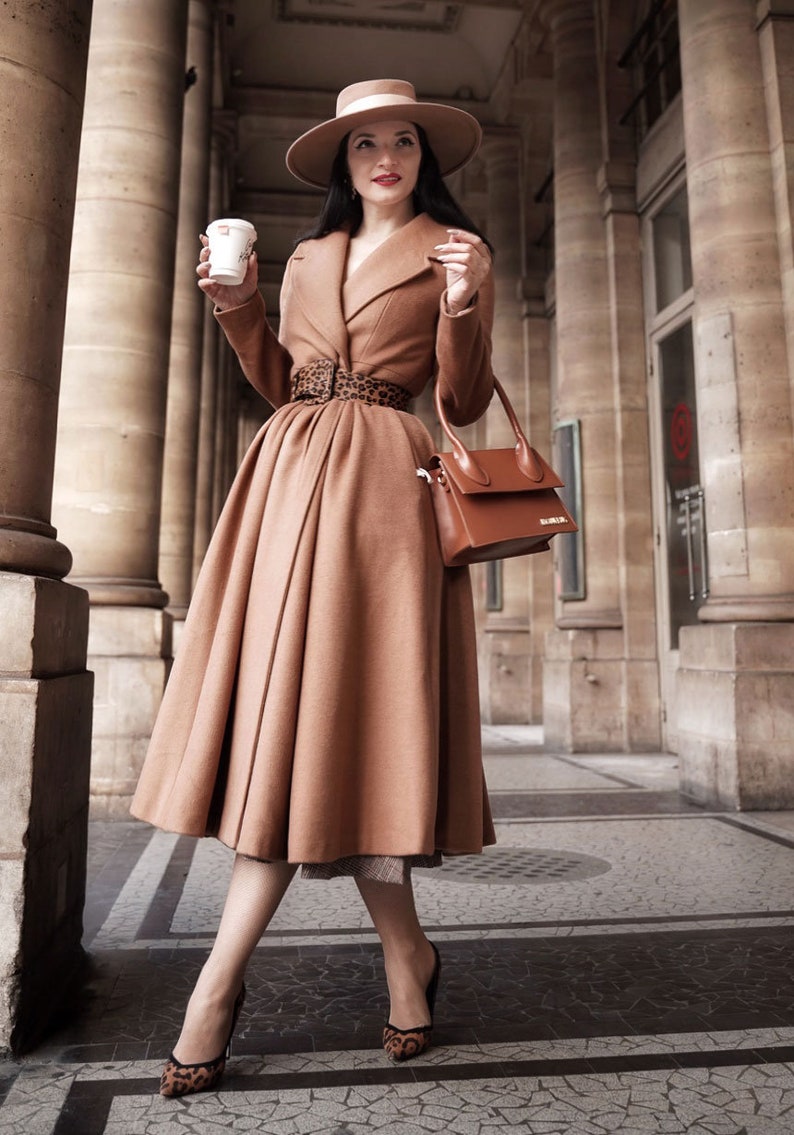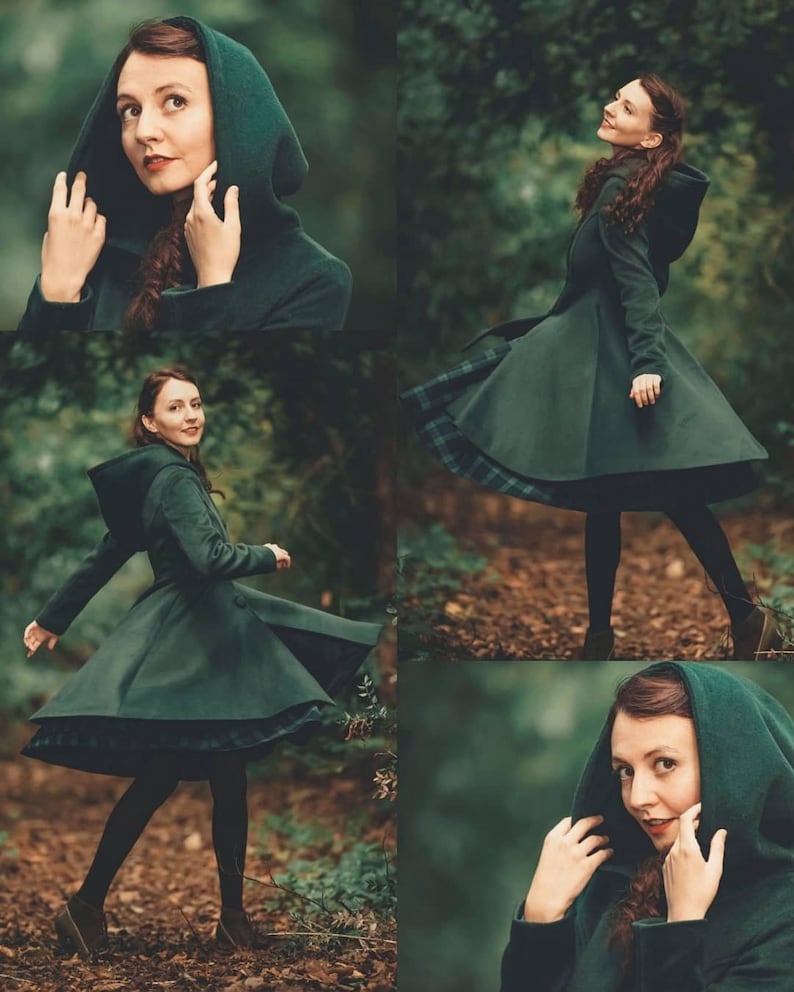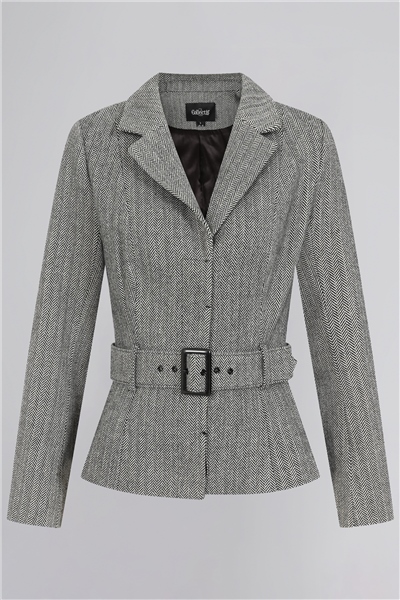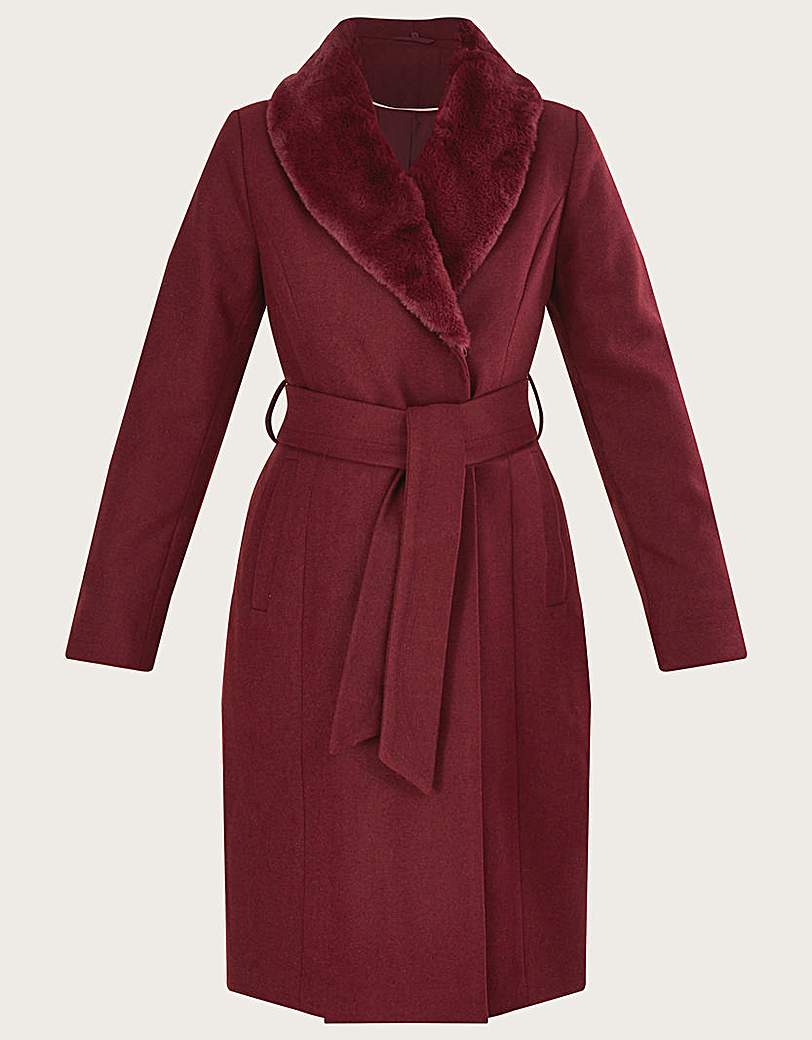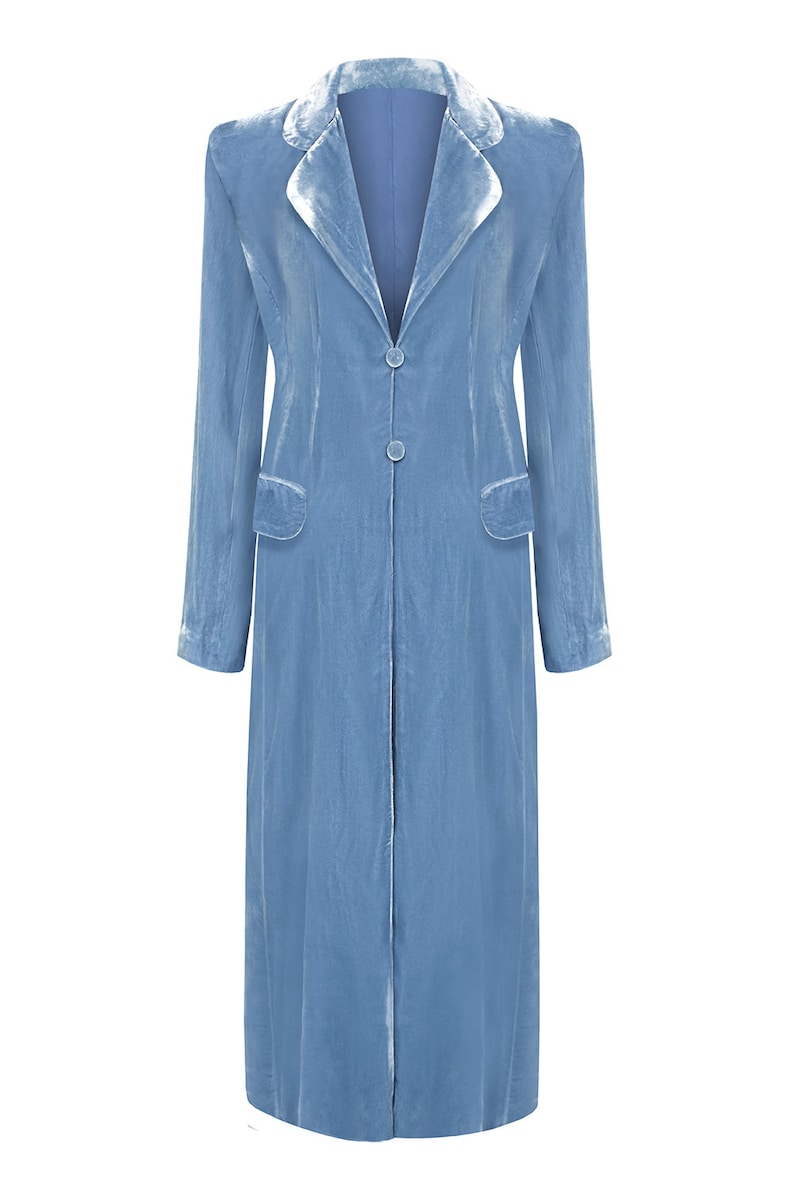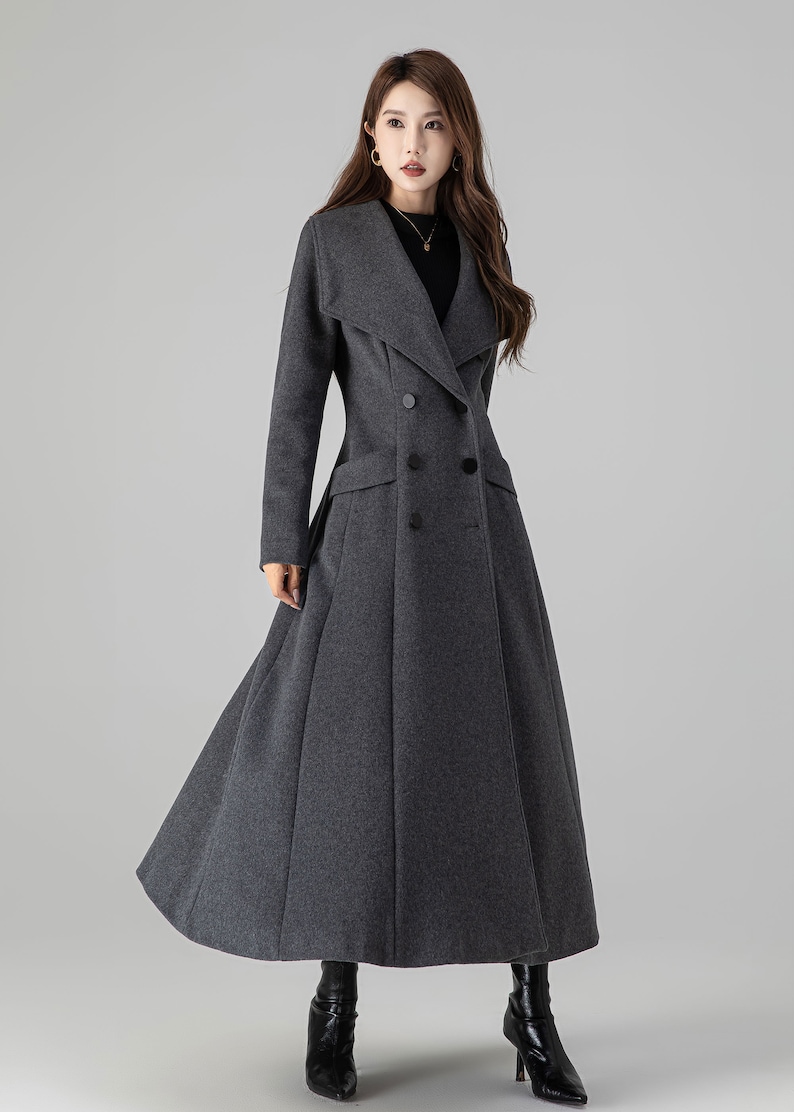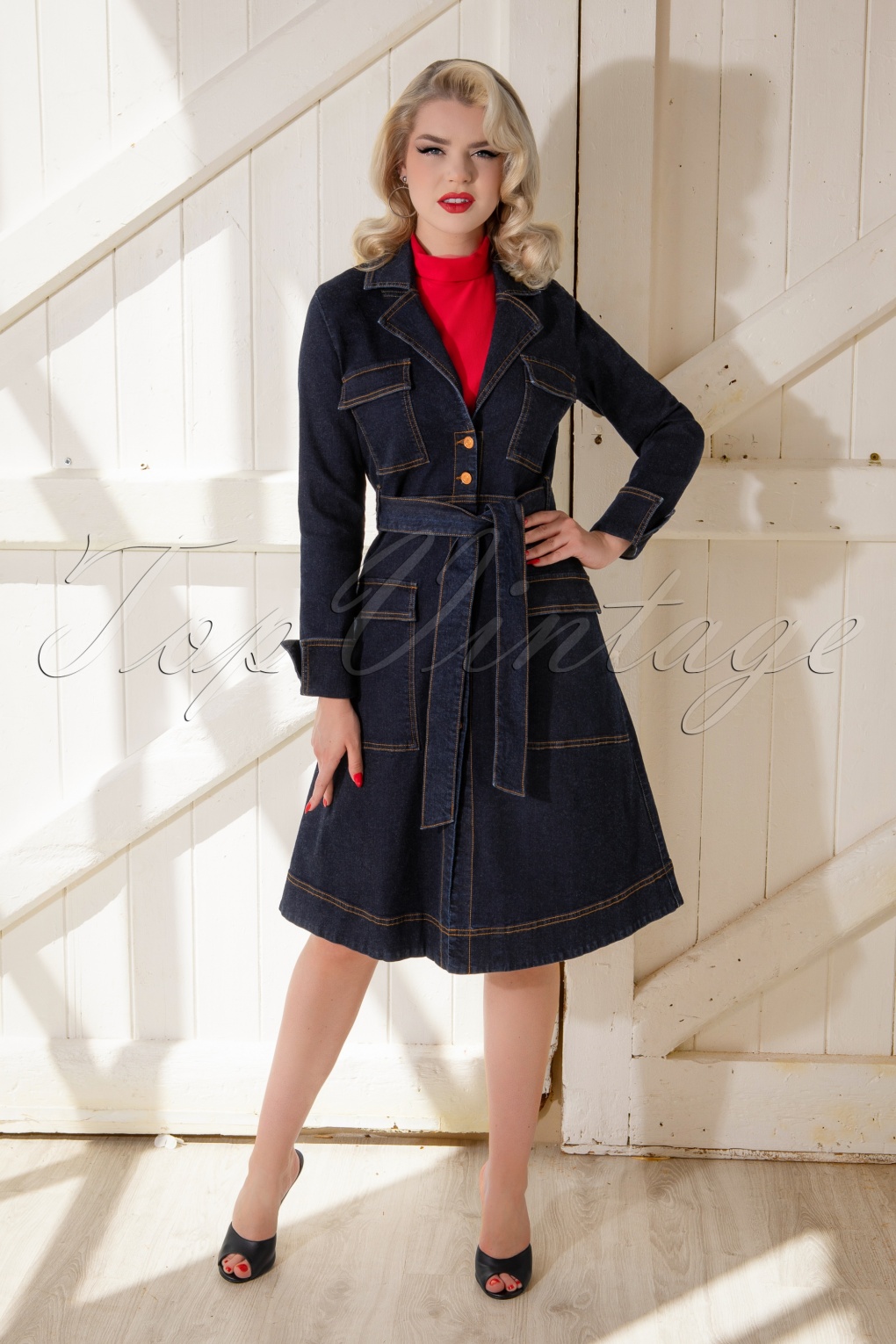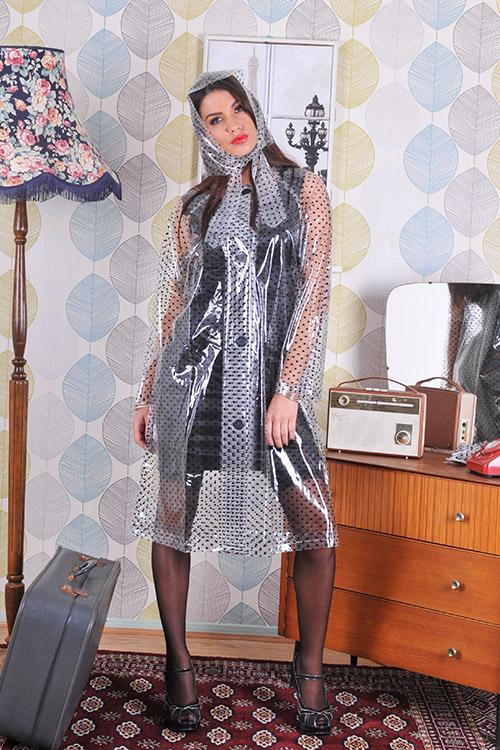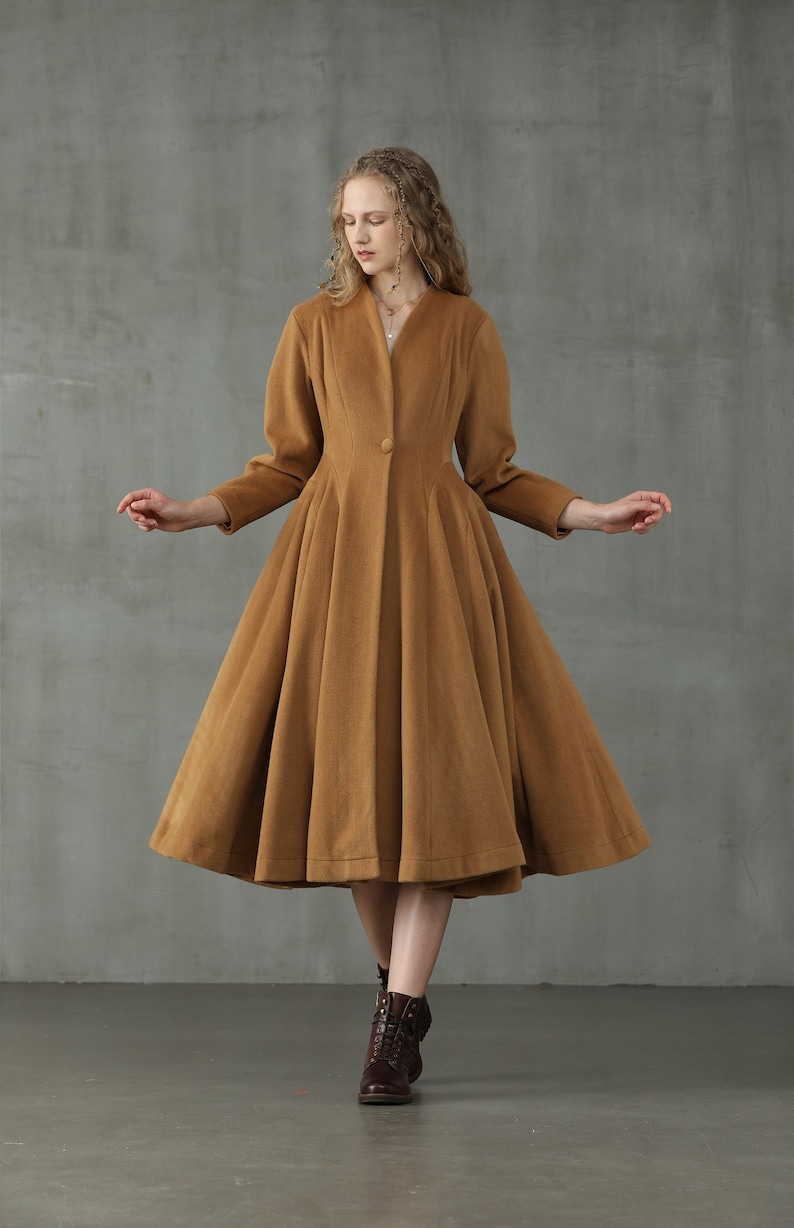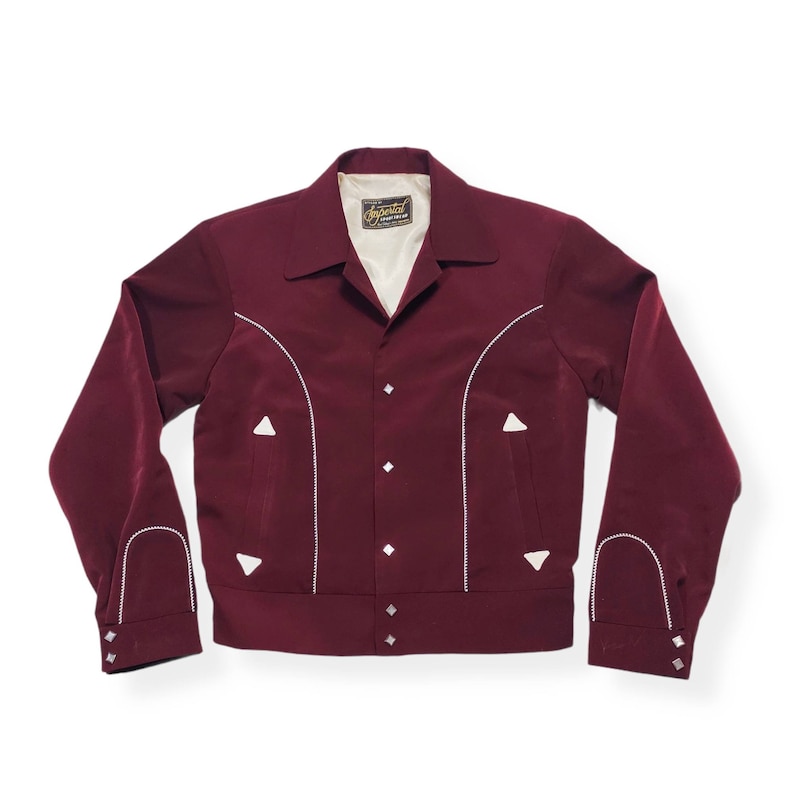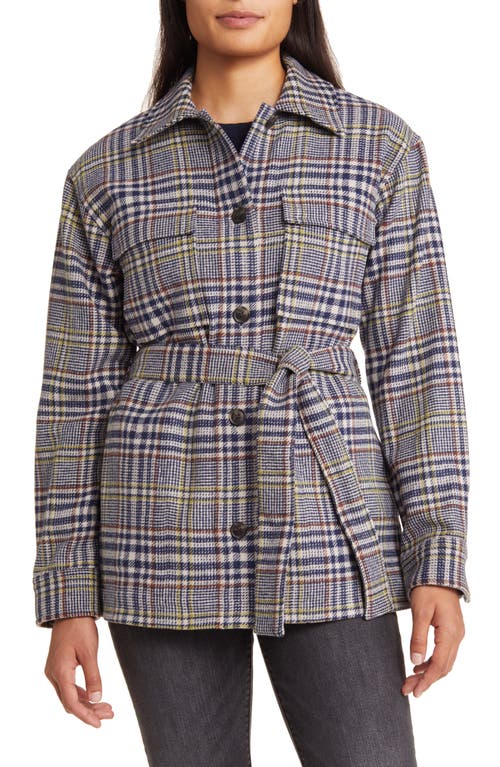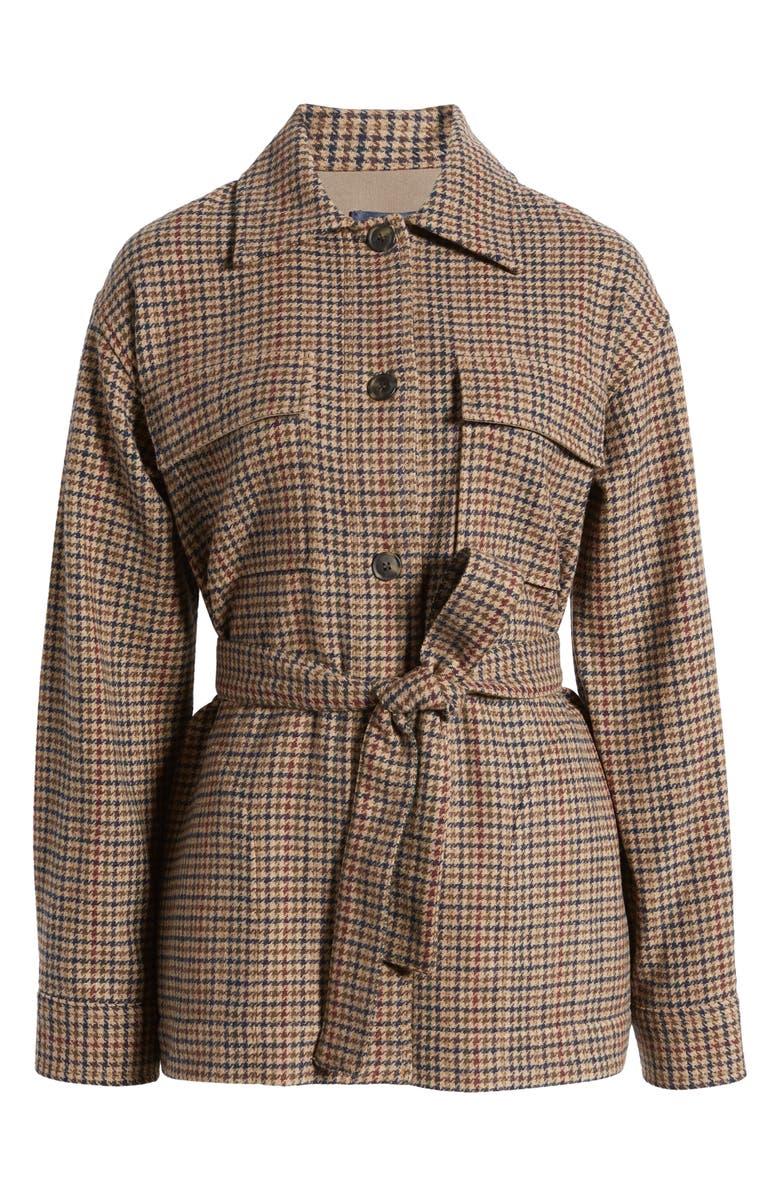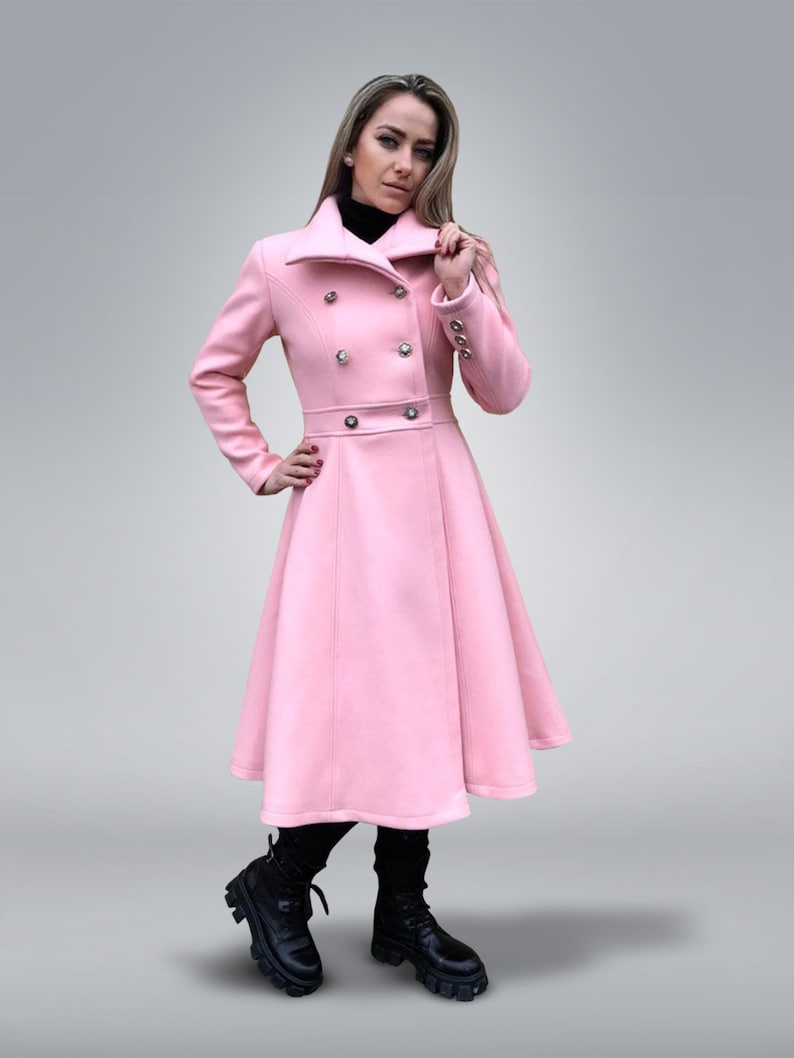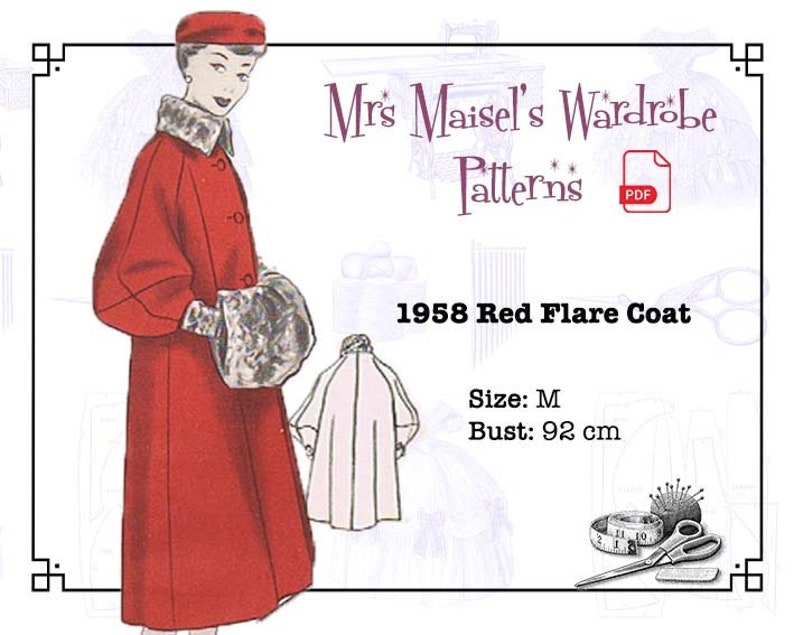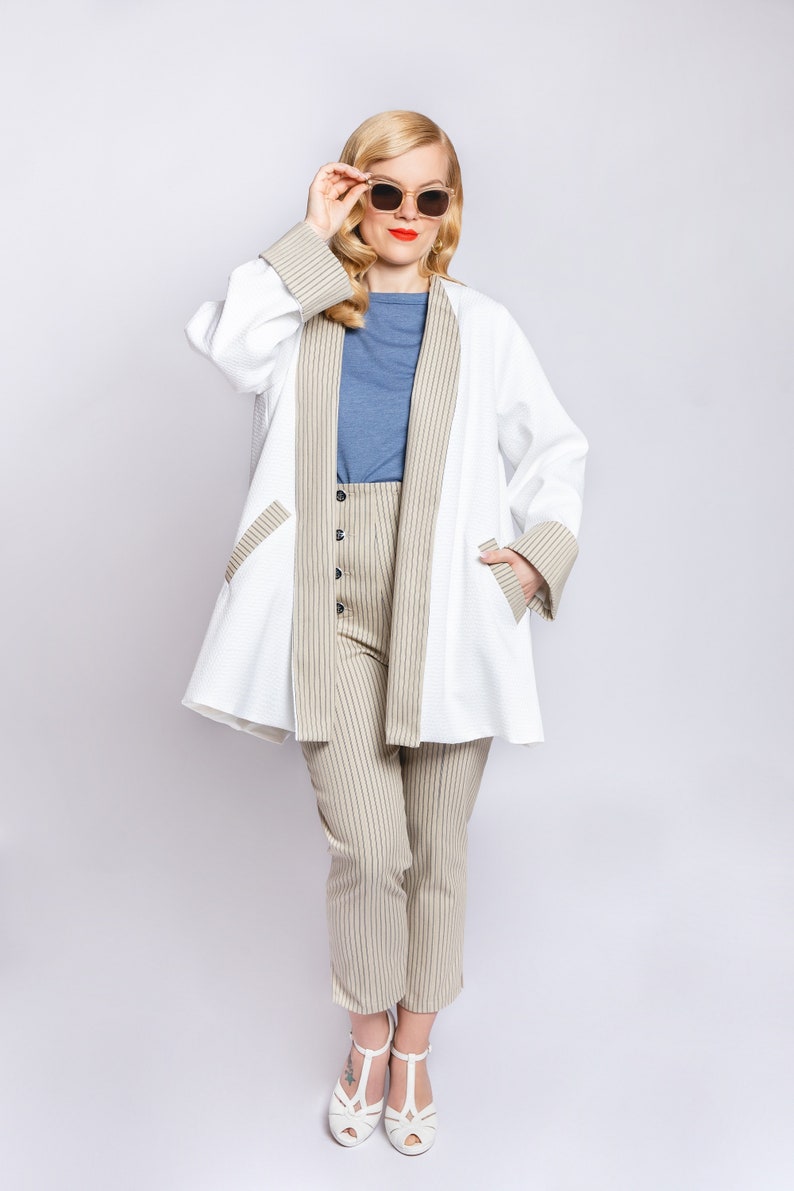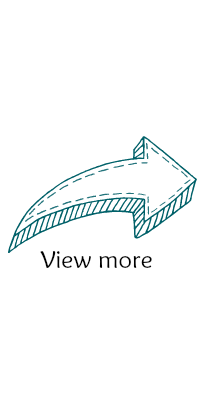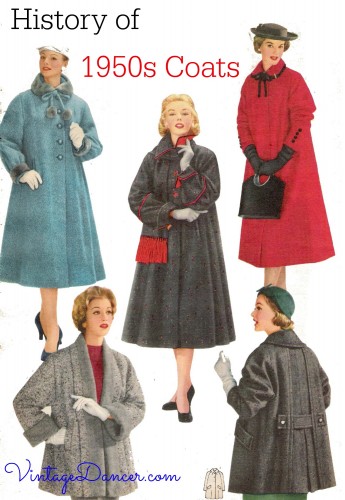
1950s coats were beautifully constructed and varied slightly in styles, fabrics, and design. Most coats were long, some coming all the way to the ankle, but others went just below the knee or sat right around the hip. Typical fabrics included camel hair, wool velour, wool fleece, tweed, and fur or cashmere if you could afford it.
Coats were often decorated with large buttons, belts, or fur collars to add a little glamour to an otherwise simple design. Fur trimmings like beaver, lamb fur, astrakhan, and mink were all popular, and a contrast lining on the inside was used to introduce interesting fashion features. 1950s coats and jackets were usually color coordinated with the rest of a woman’s ensemble.
Shop for 50s style coats here.
1950s Style Coats
Coats were usually either very fitted, semi-fitted, or full and swingy. The full coat was the most common style, although there was not a strict name for this style. For that matter, coat was not a common name in the ’50s. Instead, they were called toppers or top coats. Duster coat, Pea Coat, Long Coat, Swing Coat, Pyramid coat, Princess Coat, and Bell Coat were all used to identify ’50s full fitting coats.
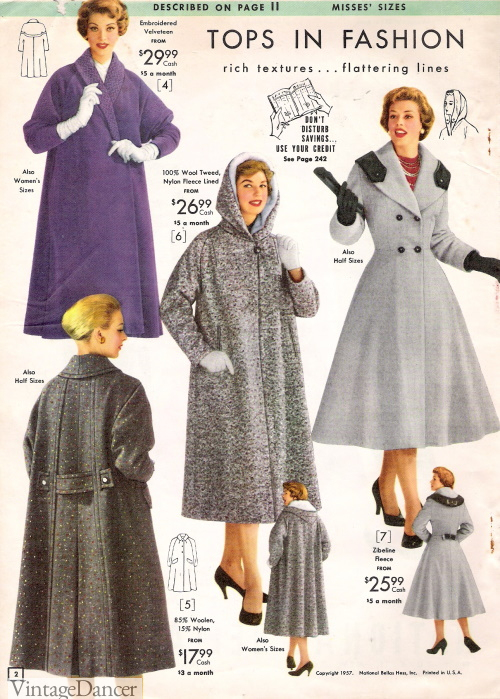
1957 Full Coats, Princess Fitted Coat
Full coats had wide sleeves, a triangular shape, large cuffs, collars, and usually large buttons as well. They came in long (to mid shin) or short (to the hip) lengths. As we know, the fifties are synonymous with full skirts, so dresses and skirts with a fuller bottom weren’t easily worn with a coat that had a straight slim style. Also, after the war we saw a boom in births, so coats that were swing style were very roomy and worked well for women who were pregnant. This was one more step a woman could take to be out in public without “showing” too much. For the time, it was a radical step.
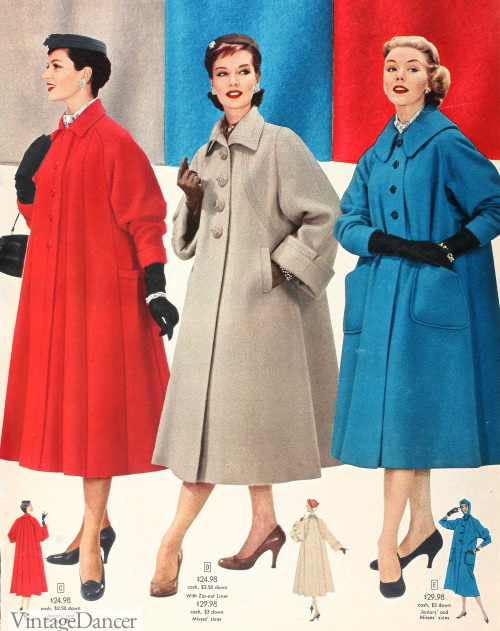
1956 Full Coats to Fit Over Full Skirted Dresses
Much like the desired figure of the fifties, many vintage coats had belts that accented the waist and flared at the bottom. Sometimes known as the princess style, these coats were feminine and figure-hugging. Popular colors were royal blue, dark red, gray, hunter green, dusty rose, black, and tan. Some coat sleeves had wide cuffs at the end or large covered buttons to add some decoration. Coats had buttons up the front, usually from the waist to the neck or just from the chest to the neck, and collars came up high to protect the back of the neck. Coats without buttons were a wrap over style similar to a trench coat.
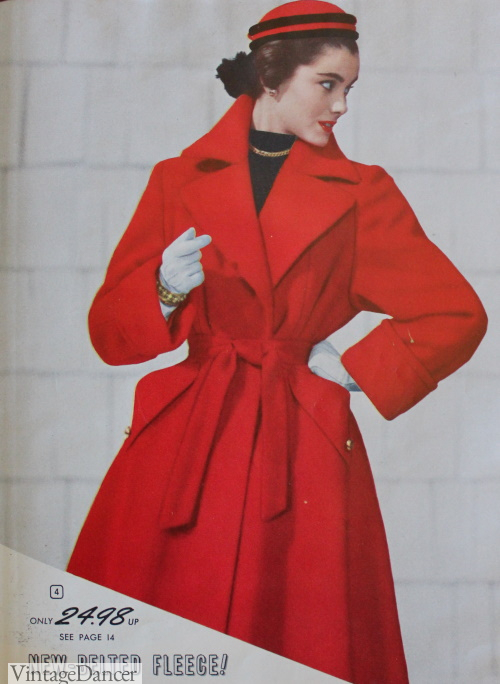
Trench Coat also called Princess Coat with Belt and full “skirt”
Many coats added pretty details with contrast stitching or embroidery, self-fabric belts, and decorative elaborate buttons. Most coats conveniently had hidden pockets. Coat collars came in all shapes and sizes, and some were made of fur. The round over-sized “Peter Pan” or “puritan style” collar was especially popular on 1950s coats. It helped make coats appear childlike or doll-like, which was the goal for women’s 1950s fashion.
As for any well-groomed woman of the fifties, it’s all about completing the look. That meant winter stockings, coordinating gloves, a matching hat, and usually a leather purse. A fur muff was borrowed from Victorian and earlier times and became a fashionable accessory to wear with furs or fur-trimmed coats (See photo under 1950s Fur Coats).
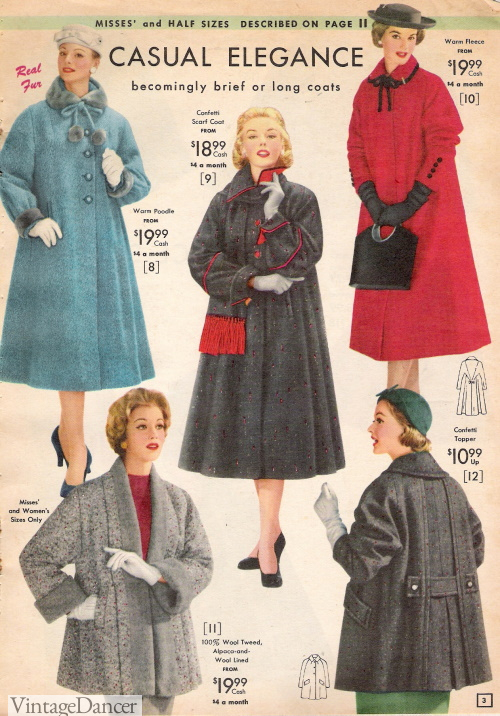
1957 Long Full Winter Coats and Half Coats with Matching Accessories
1950s Swing Coat
The swing coat or princess coat was neatly tailored and fit close to the body through the waist before widening at the bottom. It is the most common style available in repro and inspired 1950s clothing. Depending on the desired look, it usually had buttons from the chest to the waist or could be double breasted. Large pleats on the back added extra room and created movement that “swung” as a woman walked, hence the ‘swing coat’ name.
Sometimes with a belt and sometimes without, this style of coat was very flattering and mimicked the same hourglass shape that was popular at the time. The idea was to mimic the dress that was worn underneath the coat. It was also a style borrowed from Victorian ice skating coats.
- 1956 Princess Coat, Swing Coat, Shawl Coats
- 1957 Swing Back and Princess Coat in Tweed Textures
In reverse, the coat dress was inspired by the swagger coat. It was a dress with double-breasted rows of buttons on the bodice and a full swing skirt. This style was only worn in the fall and winter. Read more about the coat dress here.
1950s Box Coat
Another style is the box coat or half coat, which is arguably one of the most iconic styles of the 1940s and ’50s. It hung very wide and straight, much like the shape of a box. They either hit at the bottom of a woman’s hips or went all the way to mid-thigh. The 1950s versions often had a fuller shape than the 1940s box coats. Large pleats at the back shoulder line created a swing coat-meets-box coat style.
Collars, pockets, and buttons were large. Most came in solid colors: ivory/cream, black, blue, red, or brown. The only popular pattern available was checks. Fuzzy fabrics made for extra warm and cozy toppers.
- 1950s Yellow Topper Coat
- 1952 Short Coats
- 1956 Short “Topper” Coat
- 1957 Fuzzy Topper
1950s Lightweight Spring Coats
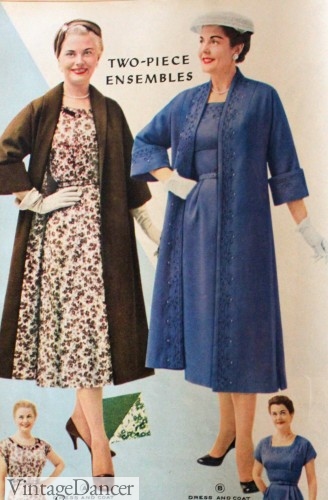
Lightweight Dress Coats for Spring and Fall
Many coats that came as coordinated sets with dresses were not heavy winter coats. Instead, they were lightweight Spring and Fall top coats that came in many names such as Clutch coat or Tuxedo coat. They often did not have pointed collars, but instead folded shawl collars that ran the length of the long coat. They were made of lightweight wools, cotton blends, and new synthetics.
Unlike winter coats, sleeves were cut full but not wide, folded up to mid arm, and the amount of “swing” at the back was minimal so that the coat hung straight over a dress. They hardly ever had buttons to hold them closed, exposing the dress underneath and the matching lining found inside the coat. Decorative embroidery was more likely seen on fashion coats than on winter coats.
- 1957 Cape Style Spring Coat
- 1957 Short Sleeve Dress Coat
- Lightweight Coats with Dresses
- 1959 Day Coats
1950s Fur Coats
Fur coats were glamorous and dressier than the everyday coat (for most people). They were cut in the same shapes as other coats of the fifties. The box coat and swagger style looked best with thick fox, sable, and seal fur. Faux furs were an option for the less affluent, as was cheap squirrel and marmot dyed to look like sable.
Sleeves were wide and open, and collars were high and closed with a longer-hair fur piece trimming the collar. To keep with the simple and polished style of fur coats, only two or three buttons or clasps kept the coat closed. Some box styles only had a single clasp at the neckline. Pockets were hidden slashes on the coat sides. The beauty (and wealth) of the woman must be showcased through her 1950s fur coat!
- 1957 Fur Collar Coats
- 1959 Faux Mink Fur Coats
While most fur coats were full length or at least hip length, a few came in shorter waist length styles. The cape coat, popular in the 1940s, remained common into the 1950s as well. Coats like this short fur Diamond brand coat (below) became increasingly popular in the late ’50s and ’60s when styles favored the slim sheath dress rather than the full circle dress.
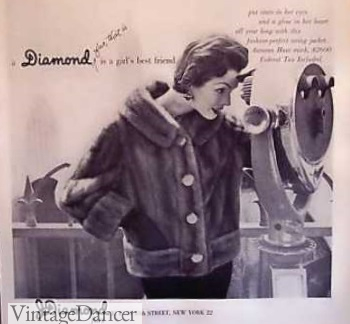
Fur Mink Short Coat
For those who could not afford a full coat, fur stoles, muffs, and shawls were a popular alternative. Fur trim on short or long jackets also added a touch of richness without the shocking price tag.
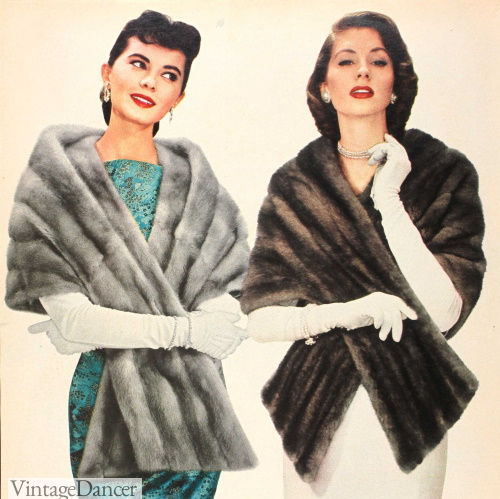
1956 Mink Fur Wraps
1950s Rain Coats
1950s raincoats were no longer just utilitarian and plain. They now came in fun patterns, such as the rain umbrellas in the below ad. They were made of a cotton-synthetic blended fabric for light waterproofing. Some were made of plastic (clear, colored, or patterned) that fit like a poncho hood with an elastic or wrap belt. Non-rubberized raincoats existed in the form of waterproof tweed, corduroy, and gabardine fabrics with an optional zip-in lining for warmth.
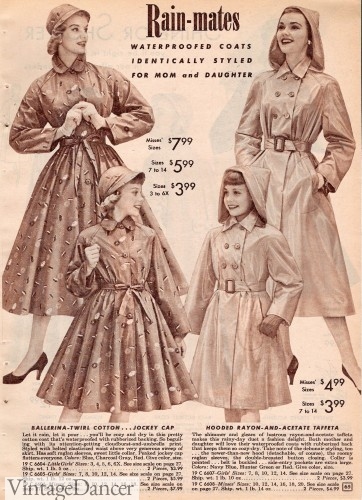
1957 Long Rain Coats for Women and Girls
1950s raincoats mostly came in trench coat style with a single or double breast and belt. They often had matching hats, too. The above are Jockey style hats, while most others were detached hoods with the brim folded back (or not when raining). Popular colors were bright red, navy blue, medium blue, turquoise, and grey.
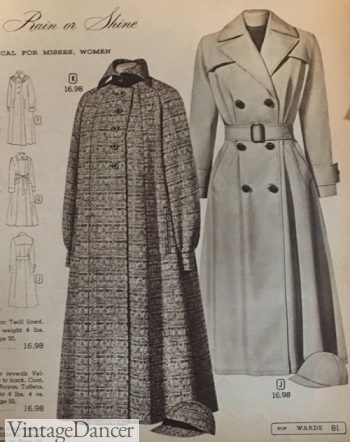
1956 Trench and Tweed Box Raincoats
For the rebellious youth and especially art students, the trend was to wear black raincoats. These also became associated with prostitutes, although I don’t know why. “Good women” chose brighter colors (pink, turquoise, red, yellow) and avoided dark colors, which were see in the rain anyways. Read more details about vintage raincoats.
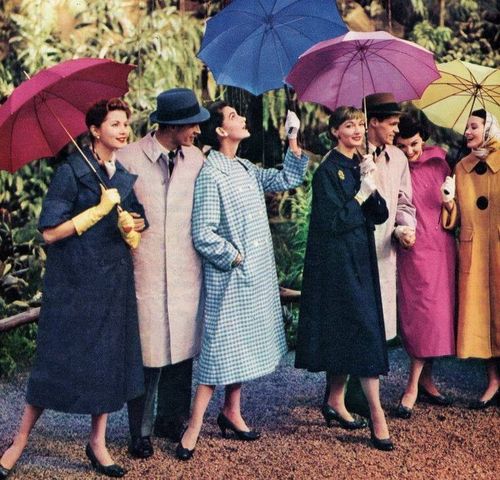
Late 1950s straight or tent shaped raincoats
1950s Winter Jackets
While the most fashionable coat was the long coat or half coat, there were numerous needs for less formal, but very practical winter jackets called surcoats. Surcoat jackets were worn paired with long skirts or pants and were reserved for cold climates with excessive rain and snow. While practical, they were not entirely void of styles. Hip length, with tie belts and point or round collars, were trademarks of the ’50s. They came with warm quilted lined flannel, cotton, or fur insides with leather, faux leather, tweed, or corduroy exteriors.
- 1955 Sporty Jackets
- 1956 Winter Casual Jackets
- 1959 Spring Jackets
- 1959 Winter Hooded Jackets
Less winter friendly jackets had a fashionable style all of their own. Many were influenced by western styles and featured fringe leather, plaid patterns, and leather or suede looking materials. The corduroy western blazer was adopted from menswear along with some other ’40s styles. They were smart, casual, and paired well with slacks or a plain skirt.
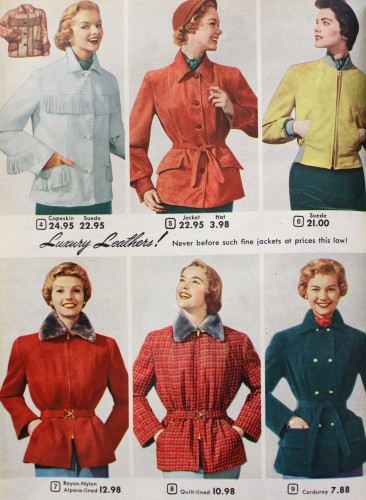
1950s Jackets- Western with fringe, suede belted, motorcycle, lined surcoat, plaid surcoat, corduroy double breasted surcoat.
The yellow “motorcycle” jacket (top right above) was another style borrowed from menswear. It usually came in a colorful leather but could also be made of cotton poplin or gabardine, just like the men’s bomber jacket. It was lighter in weight and usually worn in spring in classic men’s colors: navy, red, blue, or green.
The poodle jacket was a fuzzy winter crop jacket with a wrap-over design. It had large dolman sleeves and a narrow waistband. It looked best paired with suits and pencil dresses.
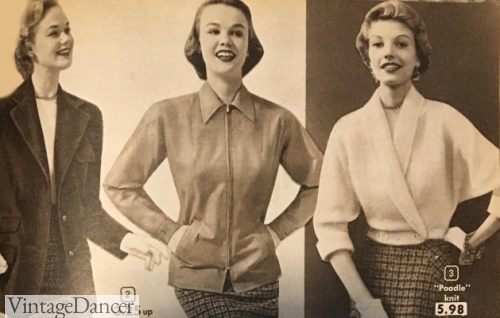
Short Casual Jackets – Western, Bomber, Poodle
Coat shopping advice from the 1950s – Buying women’s coats and suits (circa 1954) eBook online.
1950s Style Coats for Sale
Every winter, a handful of vintage reproduction jackets and long coats are sold. They are often more fashionable than warm for very cold climates, so I prefer looking for vintage or classic coats and jackets in more durable materials such as trench coats, tweed jackets, wool overcoats, and suede bomber jackets. Adding a faux fur collar can instantly transform a classic coat into a vintage treasure.
- My Newish Vintage Overcoat with Fur Collar
- Vintage 50s Coat Outfit
Read More
- 1940s Coats and Jackets for Women
- History of Vintage Raincoats for Women
- 1950s Dress Styles
- 1950s Skirts Fashion History
